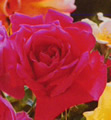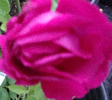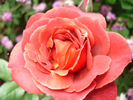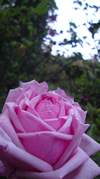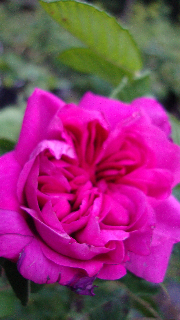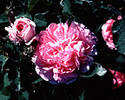Our Roses
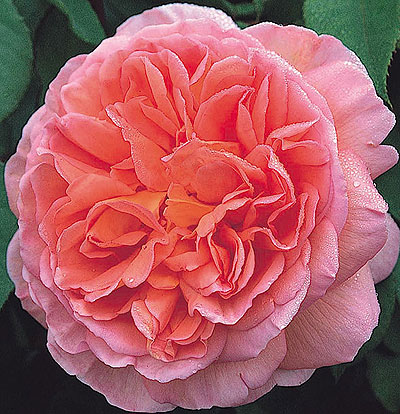
Abraham Darby. David Austin. (1985) 5 to 8 feet (if left to climb). Flowers Repeatedly. Zones 5-9.
Large cupped blossoms that are pink tinged with apricot and yellow.
They bloom throughout the season on this disease and mildew resistant
shrub. This popular plant iswell suited as a free standing shrub or can
be trained as a low climber. The blooms have a strong, fruity
fragrance and the foliage is dark green and glossy.
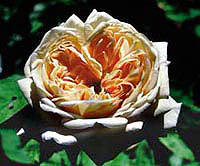
Alchymist. Climber. (1956) 10-15 feet. One long annual flowering. Zones 4-9.
Karen Kaufman, Pittsboro, North Carolina, wrote
"Every shade of peach in existence finds its way into the
blossoms, which are beautifully formed at every stage...and such
energy of growth! It is a masterpiece!" Although peach tones are
evident in deepening hues toward the center, the blooms give the
overall impression of a delightful, soft yellow. The spring bloom
is extended from early May to mid June here in California and comes on
cascading, arching canes from a strong plant with good disease
resistance.

Aloha, Climbing. Climbing Hybrid Tea. 1949. 8-10 feet. Zones 5-10.
A beloved climber with well shaped and sweetly fragrant buds that
become large full blooms of two-toned pink roses with a backdrop
of dark green disease resistant leathery leaves. It needs heat
for best color and form.
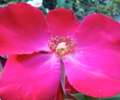
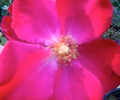
Climbing Altissimo. (1966) 6-8 feet. Flowers repeatedly. Zones 4-9.
A vigorous, heat tolerant, and disease resistant climber with long
lasting large single flowers with seven deep blood red, velvety petals
with bright yellow stamens. The blooms last long and make
beautiful cut flowers. Easily trained to grow along a fence or on a
pillar or up a tree, as well as a freestanding, upright plant.
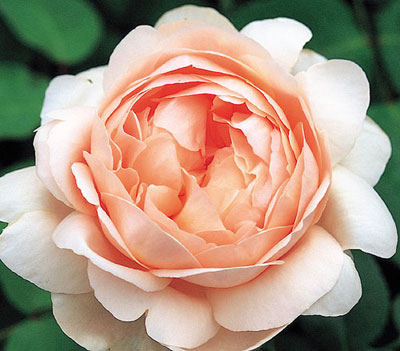
Ambridge Rose David Austin. 1990. 4 feet. Apricot Pink. Fragrant. Blooms Repeatedly. Zones 5-10.
This is one of two (Fair Bianca is the other) of Oprah's favorite roses
for her bedside table. The apricot pink rosettes have a
deliciously strong rose fragrance and the medium size blooms with
50-100 petals bloom repeatedly on a medium size bushy plant with medium
green colored foliage.

America, Climber. Large Flowered Climber. (1976) 10-12 feet. Repeat bloom. Zones 4-9.
An award winning climber with well formed large coral pink buds and blooms that have a strong spicy fragrance. Climbing America's parentage is the wonderful bright yet creamy orange "Fragrant Cloud" and "Tradition." AARS rated 8.3 as it is a proven performer that blooms on new and old wood.
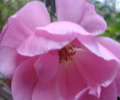
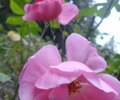
Amiga Mia. Shrub-grandiflora. (1979) 3-5 feet. Flowers repeatedly.
Griffith Buck had a great friend – one who respected and loved him, as well as his roses. Her name was Dorothy Stemler, and she was my mother.
She would have been proud to know that Griff named this rose for her. Even though he has passed away, the many hardy varieties Griffith Buck gave to us will live on and we will remember.
Graceful, shell-pink, very fragrant blossoms are borne in clusters of 6-8 or singly. The plants are disease resistant, regally tall and continuous flowering.
Jennifer Lance, of Three Mile Bay, New York, wrote us, “Amiga Mia took a 20 degree snap in early November without any cover, colder temperatures
with only a few shovelfuls of compost, and is blooming very well. I lost nearly half of my hybrid teas, and if there are roses like Amiga Mia around,
who needs those others anyway?”

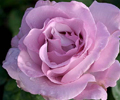
Angel Face. Floribunda. (1969) 3-4 feet. Repeat bloom. Zones 5-9.
Angel Face comes from two of our favorite lavender roses, Lavender
Pinocchio (x Circus) and Sterling Silver. A low rounded plant
with dark, leathery, glossy foliage and fully double ruffled lavender
blooms edged in purple exuding a strong citrus fragrance. In
2001, Angel Face was the James Alexander Gamble Fragrance Medal Winner,
which is awarded to very fragrant roses by the American Rose Society.
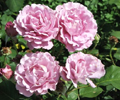
Angel Face, Climbing. Climbing Floribunda. (1981) 10-12 feet. Zones 5-9.
Climbing Angel Face is a sport of the well proven bush, and has
the same ruffled lavender flowers and strong citrus fragrance. It
can be trained along fences or walls but it should be noted it blooms
on old wood only and established plants give more bloom.
Customers have been raving about Angel Face this year so we decided to
add the climbing version as well to our selection.
Arrilaga. Hybrid Perpetual. (1929) 5-7 feet. Flowers repeatedly. (ah-ree-YAH-gah)
Two-thirds open flowers are as big as medium size cabbages . . . a rich tone of pale pink (the color raspberry juice would turn whipped cream), and fragrant.
Mrs. Leo Cloth wrote from Manhattan Beach, California, "Arrillaga is the most beautiful pink rose I have ever seen. There is not a modern Hybrid Tea rose that can touch it for size, shape or purity of color."
Guinivere agrees, "this is one of my favorite roses for cutting for arrangements from the pot pourri field."
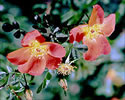
Austrian Copper. Rosa Foetida Bicolor. (Prior to 1590) 4-5 feet. One annual flowering. Zones 3-9.
The fanfare announcing the opening of the rose season. Most
brilliantly colored of all roses...the 1 inch single blooms, orange on
the
upper side of the petals, yellow on the reverse, literally cover the
plant. I have seen huge old plants in Illinois, Wisconsin and
Minnesota completely winter hardy without protection. Dislikes being
fussed over, and shows its independence by dropping spent petals,
leaving only the gold stamens on the plant. Everyone wants this rose
when it is in bloom in our garden and we seldom have enough plants to
supply the demand. Special note on pruning of the foetidas, Graham
Stuart Thomas remarked, "Pruning seldom improves the results."
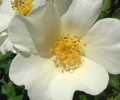
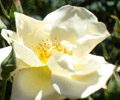
Autumn Delight. Hybrid Musk. (1933) 4-5 feet. Flowers repeatedly.
Filtered light tolerant, so you can grow this lovely Hybrid Musk under your trees and still have blossoms galore. Its amber/white buds open to wide creamy white single flowers in large fragrant trusses.
Sent to us by George Johnson, of Decatur, Georgia, who is enthusiastic with praises for its attributes, Autumn Delight will stand with the best of the roses for continual color in your casual garden.
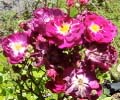
Baby Faurax. Polyantha. (1924) 8-12 inches. (BAY-bee foh-ROCKS)
A dwarf plant that puts all its energy into flowering. Blooms in
clusters of tiny buds opening to reddish violet 3/4 inch double
flowers, enlivened by a touch of white at the center and yellow
stamens. A cluster smaller than one's hand will have over 50 buds
in it . . . a miniature bouquet arranged by nature. Introduced in 1924
. . . yet still one of the best lavender toned border roses.
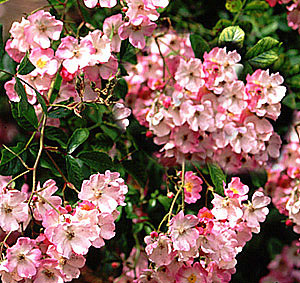
Ballerina. Hybrid Musk. (1937) 6 feet. Blooms repeatedly. Zones 5-10.
I've long wanted to add this lovely rose to our collection of Hybrid
Musks, those roses so valuable to the modern garden with their
tolerance to filtered light and disease resistant qualities. This
one is palest pink with a white center in a five petaled bloom
continually flowering in large bunches.
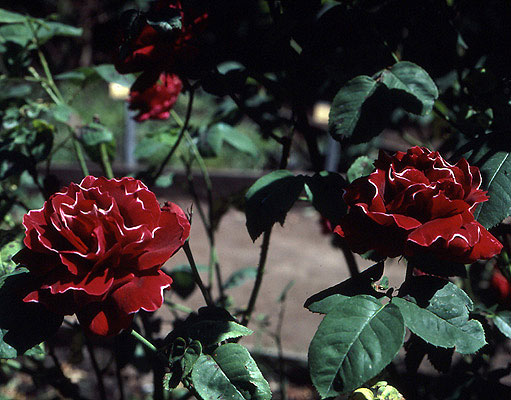
Baron Girod de L'Ain.
Hybrid Perpetual. (1897) 3-4 feet. Flowers
repeatedly. (bah-RONH zjee-ROH duh L’AHN) Zones 5 -10.
Baron Girod de l'Ain belies my statement Roger Lambelin is unique, for
it, too, has petals edged white, but the color is ruby red, instead of
maroon. A healthy, upright plant with large, medium green
foliage, few thorns and 3 inch, handsomely cupped flowers with an
intense old rose fragrance.
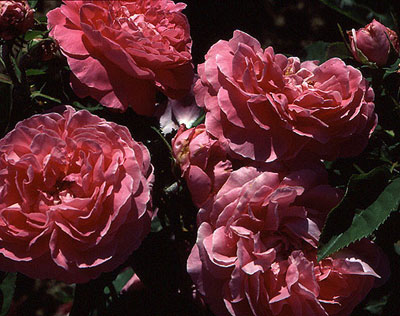
Baronne Prevost. Hybrid Perpetual. (1842) 4-5 feet. Flowers repeatedly. (bah-RAWN pray-VOH) Zones 4 -10.
Of the many Hybrid Perpetuals grown and named in the mid 1800s, Baronne
Prevost is one of the earliest, one of the finest and most
prolific. My favorite Hybrid Perpetual, probably because it has
the classic form of the best of the old roses. . . big, flat open
flowers with many small, tightly packed petals of rose pink with
silvery reverse, richly perfumed. One of the first Hybrid
Perpetuals to bloom, and it never stops until frost. A strong,
healthy, hardy, compact plant. This rose is irresistible to rose
show judges who regularly name it “Dowager Queen.”
Anita Titus Terzian, of Forest Hills, New Jersey, wrote, “What a
wonderful, vigorous plant - healthy leaves and gorgeous blooms!
The powerful perfume does not dissipate and the plants kept on blooming
until November.”
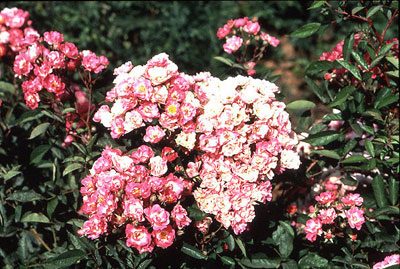
Belinda. Hybrid Musk. (1936) 4-6 feet. Flowers repeatedly. Zones 5 -10.
A great rose with a strong constitution. Literally covers itself
with large trusses of lightly fragrant, bright pink, 1 inch semi double
flowers, and it does this in filtered light
as well as sun. Has healthy, clean foliage under all
conditions. One of the best Hybrid Musks for hedgerow use, or as
a fountaining pillar, supported by a post. If you want a rose
that takes little care and fussing, and is one of the most beautiful
and colorful, Belinda is your answer.
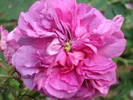
Belle de Crecy. Gallica. (Prior to 1848) 4 feet. One annual flowering. Zones 5-9. (bell duh cray-SEE)
The 3 1/2 to 4 inch flowers open wide and flat, with many petals and a
green eye at the center, much like the classic Madame Hardy. When
newly open he petals are cerise pink, shaded with violet, their
reverse silvery blue violet. Then the outer petals quickly change
to blue violet. The canes are rather lax and may be pegged over
in an arched position which causes upright blooming stems to break all
along them, or otherwise given them support. Graham Thomas, who I
believe knows more old roses intimately than anyone, writes in his fine
book, The Old Shrub Roses, “Belle de Crecy is supreme among all
old roses, and for the fragrance it is hard to beat.”
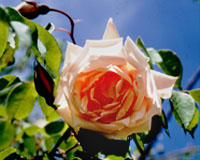
Belle of Portugal. Hybrid Gigantea. (1903) 20-30 feet. One annual flowering. Zones 8-10.
Belle of Portugal grows all over California in places where it gets no
care at all, and blooms in great profusion late in April and during
May. Also called “Belle Portugaise”, it is a great favorite with
many memories. Its long canes are highly adapted to “tree
climbing,” and the very long, pointed buds open to 4-5 inch flesh pink,
loose blooms with long petals. Nicely fragrant, with long cutting
stems. Belle of Portugal dislikes too much fertilizing with nitrogen
rich fertilizers - feed once after the spring flowering using a good
all around rose food, then follow with monthly feedings of a fertilizer
that is richer in phosphates and potash than nitrogen.
Belle Poitevine. Rugosa. (1894) 4-6 feet. Flowers repeatedly. (bell-pwo-tuh-VEEN)
No roses beat out the Rugosas for garden ornament. The hardiest
of all, they create beautiful pictures, are resistant to rose pests,
mildew, rust and blackspot, and need no pruning, except to remove dead
wood. However, they do not mind being trimmed to any shape and
size desired. Belle Poitevine produces a constant parade of double
lilac pink, 4 inch blooms with an intense fragrance that bees and
humans love. After the petals drop large red heps form that are
high in Vitamin C. Jean Schubert, Boonville, Missouri, wrote, " . . .
this year I planted Belle Poitevine in a new shrub border and I think
it has won over my heart . . . for pure visual beauty in a landscape it
takes the prize."
Bewitched. Hybrid Tea. (1967) 4-5 feet. Flowers repeatedly. Zones 5-9.
By request of Len Edwards, a long-standing customer from Los Altos
Hills, we have added this cotton candy pink rose to our list of Hybrid
Teas. Rich damask
fragrance and long, strong cutting stems on a vigorous bush make this
Hybrid Tea a classic. Established plants give the best bloom, and
this rose particularly enjoys a good drink of water regularly to
support all of those wonderful large blooms it produces all season
long. Holds its color in midsummer heat although best size and color
are in somewhat cooler conditions.
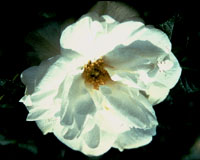
Blanc Double de Coubert. Rugosa. (1892) 3-5 feet. Flowers repeatedly. (blahn DOO-bluh duh koo-BEAR) Zones 3-9.
Handsome rugose foliage, hardy anywhere...the best of the few white
Rugosas in existence. Cycle after cycle of large, purest white,
fairly double flowers, followed by Vitamin C rich hips that ripen to a
glowing red. Mary Hamre, of Molalla, Oregon, wrote about Blanc Double
de Coubert, "My two bushes of 'Blanc' are among the first to bloom in
the Spring and have lovely clusters of pure white blooms continuously
until Fall frost. They are easy to care for...no pruning, spraying or
winter protection is required. Fragrance is like French talc and wafts
all around them...no contest when compared to any other rose.
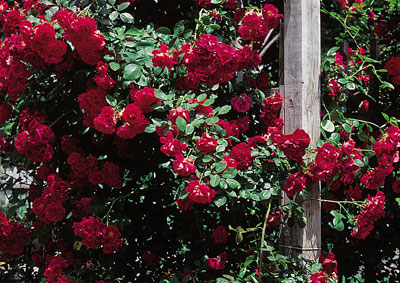
Blaze Improved, Climbing. Large Flowered Climber. 1932. 12-14 feet. Flowers repeatedly. Zones 4-9.
One of the most popular climbing roses, this consistent performer
produces abundant clusters of pure scarlet red flowers. Semi
double medium size blooms (2 to 3 inches across) in large clusters have
a light tea fragrance and bloom on old and new wood. Easy to grow with
a vigorous upright habit that is easy and quick to train on fences,
arbors, pillars, and porches.

Blush Noisette. Noisette. (Prior to 1817) 5-10 feet. Blooms repeatedly. Zones 6-10. (nwah-ZETT)
Famous in England for the astounding flushes of white bloom with pale
pink blush. Long canes arch gracefully bearing their load of
fragrant flowers with aplomb. This rose is wonderful, whether
used as a climber against a wall or fence, or as a self-supporting
plant. I can just picture it in front of a white picket fence, by
a country cottage surrounded by a garden full of pink cabbage roses and
perennials!
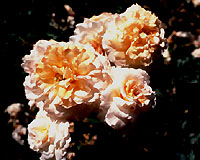
Buff Beauty. Hybrid Musk. (1939) 5-7 feet. Flowers repeatedly. Zones 4-10.
The very full 3 inch blooms have a translucent quality, like light
shining through sheer fabric. Its apricot yellow buds and old
gold to cream colored flowers, blooming in clusters, are delightful. A valuable rose for banks, fences,
or low retaining walls. From Irene McKinney, Lompoc, CA came this
comment. "Buff Beauty has been out of this world this season, it's third year. A solid wall of
clusters of flowers, They have a marvelous inward glow, shining
with great beauty. . . very creamy/ peachy/ buff.
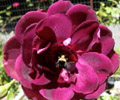
Burgundy Iceberg. Floribunda. 3-4 feet. (2007) Flowers repeatedly. Zones 4-9
Discovered in Dural, New South Wales, Australia, in the fall of 1998,
Burgundy Iceberg is a descendant of Brilliant Pink Iceberg, Iceberg and
Robin Hood, from which it receives its burgundy color. The
pointed burgundy buds unfold deep purple petals with a lighter reverse
on nearly thornless stems. The stamens and aonthers are burgundy
red and at the end of the bloom cycle a white eye appears at the base
of the petals. The blossoms have a mild honey fragrance that some may
find hard to detect. Like Iceberg and Robin Hood, Burgundy Iceberg
makes a great landscape plant. It is a prolific bloomer with a rounded,
bushy habit, as well as disease resistance and cold hardiness.
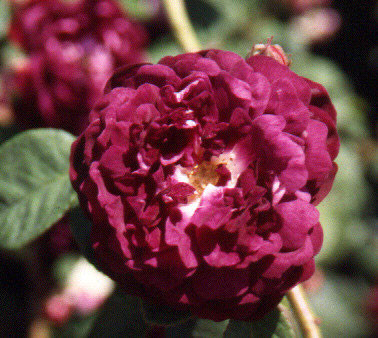
Cardinal de Richelieu. Gallica. (1840) 4-5 feet. One annual flowering. Zones 3-9. (kar-dee-NAHL duh reesh-LYUH)
This is a great companion rose in the old fashioned rose garden.
Planted in an area with several Albas and Damasks, it cannot be beat
for bringing life to all colors in its
vicinity. Fat, rounded buds open an unusual coppery rose with violet
overtone, deepening to the richest violet imaginable. The reverse
of the petals is rosy silver. As the blooms age they get an
almost metallic silvery blue color mixed with the velvety purple.
The plant is one of the best of the Gallica family with few thorns and
dark foliage. Fragrance appears as petals dry, an unusual feature
of an unusual rose.
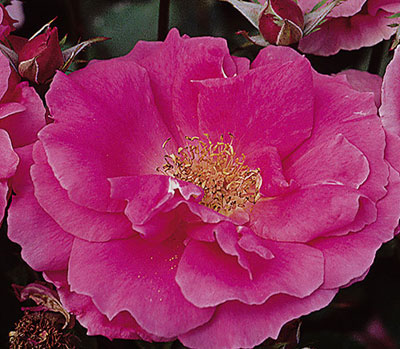
Carefree Beauty. Floribunda. (1977) 2-4 feet. Blooms repeatedly. Zones 4-10.
Carefree Beauty is a floribunda in habit and style, with long buds in
small clusters, hybridized by Griffith Buck. He was a master of
creating hardy, disease resistant, repeat blooming, and fragrant
roses. See more about him at Iowa State University's web site: http://www.exnet.iastate.edu/pages/hancock/hort/educ/GBRoses.html
Carefree Beauty is excellent as a bushy ever blooming shrub. It is
useful as a bedding plant with herbaceous perennials and annuals.
The flowers are semi double, rich pink, 4 1/2 - 5 inch and slightly
cupped with a pleasant rose fragrance. Carefree Beauty has
leathery, dark green foliage that is resistant to black spot and
powdery mildew, and is very winter hardy. It has an AARS rating
of 8.7.
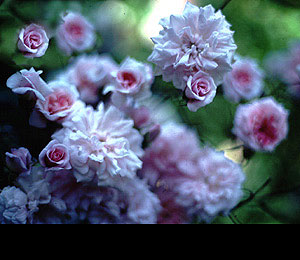
Cecile Brunner. Polyantha. (1881) 3 feet. Flowers repeatedly. Zones 4-9. (say-SEAL BROO-nur)
This old-fashioned favorite has very pretty flowers and makes an
extremely ornamental and versatile garden plant. The blooms, at
their fullest, are 2 1/2 inches across with a sweet, clear perfume. Its
low-thorned stems, fragrance, and dark green leaves make it a natural
for boutonnieres. It is suitable for the front of a border, a
small place in the garden close to a sitting spot, for a pot, and
countless other places. Andy Wiley recommends planting Cecile Brunner
below Cli. Cecile Brunner for a full top to bottom look.
Cecile Brunner, Climbing. Climbing Polyantha. (1894) 15-20 feet. Intermittent bloom.
The charming "sweatheart rose" which is especially fine in climbing form. A mass of bloom in the spring (We have a plant here that is climbing into a redwood tree-it will climb almost any kind if given the chance!) continuing through the summer with always some bloom on the plant. Perfect pink buds open to 1 1/2 inch double reflexed flowers, borne in loose clusters where each bloom has a good stem. Vigorous. . . needs room to be at its best.
Celestial. Celeste. Alba. (1759) 4 to 6 feet. One annual flowering. Zones 4-9.
An historically important rose, also called by such names as “Aurora”
and “Minden Rose”. Planted along the road, where it gets very
little sun, our plant is a graceful, self-supporting shrub about seven
feet high, but I do not feel it would be quite as tall when grown in
full sun. Its grey-green foliage is a perfect foil for the clear
pink, semi double blooms that are exquisite in each stage of opening.
Fragrant.
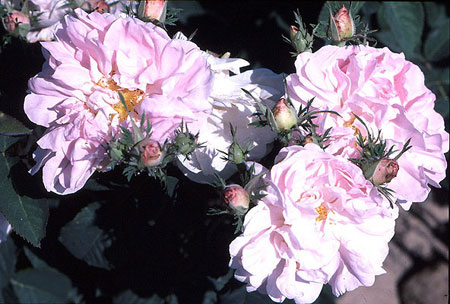
Celsiana. Damask. (Prior to 1750) 4-5 feet. One annual flowering. Zones 4-9. (sell-see-AH-nah)
The subject of one of Redoute’s most beautiful rose portraits, and a
rose to inspire any artist. Leigh Barr Stamler, St. Louis, MO, says,
“Celsiana is incredibly beautiful -
arching canes loaded with soft, lovely roses in the most perfect shade
of pink! I sit on the grass in front of her for long minutes every
spring, drinking in her beauty.”
A graceful plant with smooth, grey-green foliage and clusters of 4 inch
warm pink flowers . . . which open wide with a special crisp twirl of
crinkled petals showing tall yellow stamens. True damask
fragrance . . . if you plan to make potpourri, this rose should be
included in your order.
Charlotte Armstrong. Hybrid Tea. (1941) 4 feet. Flowers repeatedly. Zones 5-10.
This is the tried and true hybrid tea - has all the plant and bloom virtues that anyone could ask for - ease of growth and excellent performance in the garden. The long, beautifully formed buds are a standard of excellence - the color is variable according to climate but I think "rose-red" best describes it. A lot of good rosarians have voted Charlotte the highest honors. The red buds open to big sweetly scented deep pink blooms. Prefers cool spring and fall conditions.
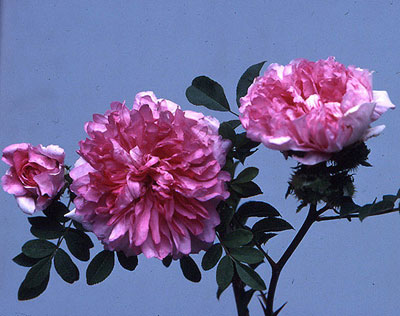
Chestnut Rose. Rosa Roxburghii. (Prior to 1814) 5-8 feet. Flowers repeatedly. Zones 5-10.
Fernlike foliage, angling, arched branches that shed their bark as they
age, buds that resemble chestnut burrs, and wonderful deep pink, very
double blossoms that are present on the plant from early spring through
late fall. This is one of the most desirable and interesting
roses we grow - nothing really like it in all of rosedom!

Chorale. Griffith Buck Rose. Shrub. (1978) 4 feet. Blooms repeatedly. Zones 4-10.
Another of the fantastic Griffith Buck roses that make wonderful rose bushes for the landscape. This time, he brings us a very delicate and true light pink rose, with a high-centered bloom form consisting of 50 petals, on a graceful and hardy bush with beautiful glossy, dark green, disease resistant foliage.

Climbing America. Large Flowered Climber. 1976. 10-12 ft. Repeat bloom. Zones 4-9.
An award winning climber with well formed large coral pink buds and
blooms that have a strong spicy fragrance. Cli. America's
parentage is the wonderful bright yet
creamy orange "Fragrant Cloud" and "Tradition". AARS rated 8.3 as
it is a proven performer which blooms on new and old wood.
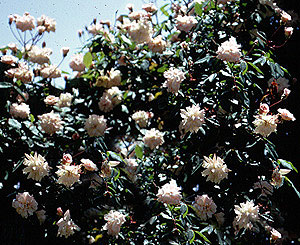
Climbing Cecile Brunner. Climbing polyantha. (1894) 15-20 feet. Intermittent bloom. Zones 4-9.
The charming "sweetheart rose" which is especially fine in climbing
form. A mass of bloom in the spring (We have a plant here
that is climbing into a redwood tree - it will climb into almost any
kind if given the chance!) continuing through the summer with always
some bloom on the plant. Perfect pink buds open to 2 1/2 inch
double reflexed flowers, borne in loose clusters where each bloom has a
good stem. Vigorous...needs room to be at its best. Andy Wiley
recommends planting Cecile Brunner below Cli. Cecile Brunner for a full
top to bottom look.
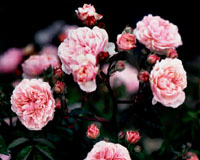
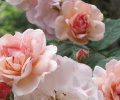
Cornelia. Hybrid Musk. (1925) 6-8 feet. Flowers repeatedly. Zones 5-10.
As I plan the catalog, I begin collecting comments from some of you
who write to us about your particular favorites. One such comment came
from Carol Cunningham in Carmel Valley, CA. "I simply had
to write you about one of the roses you sell, Cornelia. Her coral buds open
to delicate pink, with a touch of gold at the base of each petal...but it's the
fragrance I love! It is a mixture of heliotrope and narcissus,
something I've never smelled in a rose!"
As with all the Hybrid Musks, Cornelia has disease resistant foliage
and is happy in full sun or filtered light.
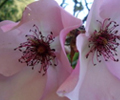
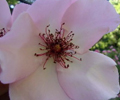
Dainty Bess, Climber. Hybrid Tea. (1925) 7-10 feet. Flowers repeatedly. Zones 5-10.
A classic among Hybrid Teas, known and loved by almost everyone. Long,
slim buds open to 4 inch blossoms of dusky pink with five
graceful petals surrounding long maroon stamens. Exceptionally
long lasting on the plant and in bouquets. A stand-out in our
garden, always in bloom. In every way like the bush, but more plant and more bloom. Blooms without pause and always looks neat, for the spent petals fall, cleaning the plant. There is a plant of Climbing Dainty Bess in WAtsonville that has been trained as a pillar in the corner of a small garden. The color and simple form make an exquisite picture - I drive by at least twice a year to gaze at its beauty.
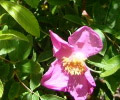
Delicata. Rugosa. (1898) 3-4 feet. Flowers repeatedly. Zones 3-9.
All the Rugosa roses are perfect subjects for the organic gardening
enthusiast. They are extremely hardy, disease resistant, beautiful and
fragrant garden roses,
and produce large hips with the highest Vitamin C content of anything
grown, even oranges. Delicata's large, semidouble, lilac pink flowers
on short stems surrounded by mint-like foliage have a tantalizing
fragrance. When the flowers are spent, hips the size and color of
crabapples form. While the hips are ripening, often a flowering
stem will grow from just below them, so the plant is producing flowers
and hips at the same time. Quite a feat for a rose!
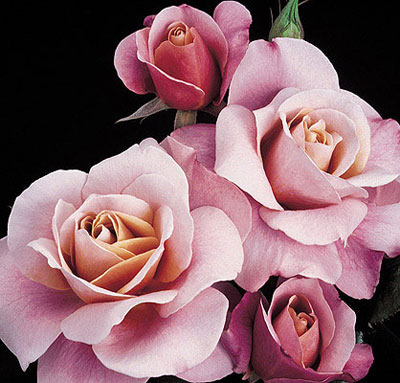
Distant Drums. Griffith Buck. (1985) 3 to 4 feet. Flowers repeatedly. Zones 5-9.
A novel rose from among the hardy roses hybridized by Griffith Buck.
Distant drums has medium large, ruffled, double blooms which are rose
purple to orchid pink tinted golden tan in the center, and fading to
pale lavender and tan with age. Distant Drums is a vigorous and
bushy erect plant which blends well in a formal or relaxed garden, and
has an intense myrrh fragrance.
Don Juan, Climbing. Large Flowered Climber. (1958) 12-14 feet. Blooms repeatedly. Zones 4-9.
One of the best of the fragrant, dark red climbing roses with large,
shapely full blooms and glossy dark green leaves. Deep velvety
red flowers have a strong rose fragrance. Blooms on new and old
wood.
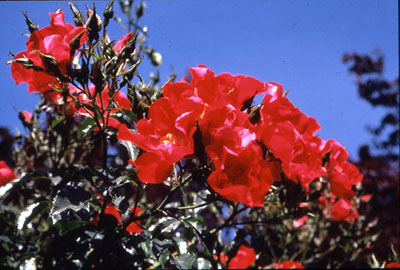
Dortmund (climbing). Kordesii. (1955) 10-15 feet. Blooms repeatedly. Zones 4-9. (DORT-moont)
Mrs. R. C. Gibbons, Richardson, Texas, wrote, "You should
put an extra note in your catalog recommending Dortmund as a fine
landscape fence or bordering rose. The glossy strong foliage
rivals the best holly, with thebonus of beautiful flowers, too!
When some of my modern "Award of Excellence" roses are producing
foliage with no enthusiasm and are limping lazily along in the 100 plus
degree weeks, the Dortmund stands proudly erect, thriving despite the
scorching days." That's a wonderful recommendation, and I can
only add that Dortmund's blossoms are luminous, brilliant red with a
touch of white at the center, and they are delightfully fragrant.
There is no urgency to cut old bloom as the petals fall cleanly and
lovely bunches of bright orange hips form, with the plant still putting
out lots of bloom.
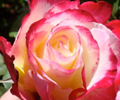
Double Delight. Hybrid Tea. (1977) 3-4 feet. Blooms repeatedly. Zones 5-10.
After so many requests for this popular variety, we have decided to add
it to our catalog. With several important qualities in a rose -
strong rose fragrance, eye-catching color, and good cutting stems,
Double Delight serves well in the garden, as a prolific free flowering
bush with well formed, creamy pointed buds that blush red in the sun.
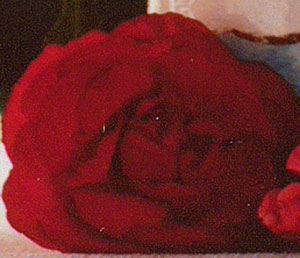
Dublin Bay, Climbing. (1976) Large Flowered Climber. 8-12 feet. Blooms repeatedly. Zone 4-10.
Large, fully double true red flowers bloom on old and new wood, with
lots of deep green disease resistant foliage. Is suitable for
training as a pillar, and blooms well even in cold weather and takes
the heat well, too. The blooms have a moderate fruity fragrance,
good form, and not only last well, but bloom repeatedly throughout the
season. I don't think I have seen the potted roses this season
ever be without blooms.
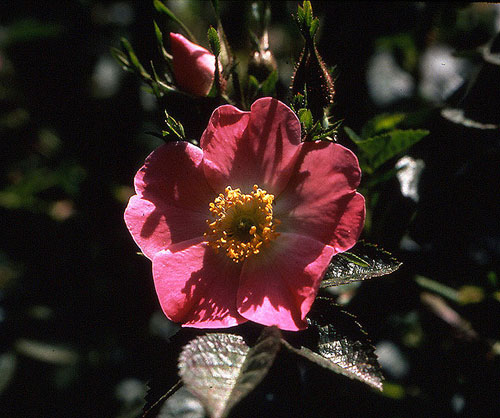
Eglantine. Sweetbrier. (Ancient) 10-14 feet. One annual flowering. Zones 4-9. (EGG-lahn-tyne)
One of my happiest memories of Brown's Valley will always be the
delightful odor of crisp green apples that greets me on dewy mornings
from the plant of Eglantine that grows along the driveway leading to
our home and office. A big, strong shrub or climbing rose, is more
contained in cold climates than here in California where it sometimes
reaches the height of climbers. Used extensively in England for
big hedges, and brought to America by the early settlers to remind them
of home. The small, single flowers, like “exquisite rose pink
jewels hung on soft, crumpled green leather,” are followed by a big
crop of oblong orange hips.
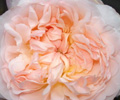
Evelyn. Shrub. David Austin. (1991) 4 to 5 feet. Blooms repeatedly. Zones 5-10.
A descendent of Graham Thomas and Tamora, this rose has their qualities
of fragrance, color, and form, in a winning combination. Large
cupped apricot blooms with a strong fragrance bloom repeatedly on this
shrub that gets 4 to 5 feet, but like many of the Austin’s, can double
that size and climb if left unpruned. The large blooms do not
last as well in unrelenting sun and the rose may do better in cooler
climates or a spot that has some shade part of the day.

The Fairy. Polyantha. (1941) 2-3 1/2 feet. Repeat bloom. Zones 4-9.
In 1956 Will Tillotson wrote...“In ten successive catalogs, the writer
has offered to 'match this beautiful Polyantha against the field and
take all bets.' Except under the desert blistering sun, where its
mid-summer blooms fade to white, The Fairy is unexcelled for vigor,
spreading growth, perfect health and hardiness, and its super ability
to produce those charming pink rosette type blossoms in constant
abundance...each fair flower, crisp and waxen like a pink sea shell.'
Polyanthas come and go, but The Fairy will be with us long after many
of todays favorites are forgotten. Needs full sun for blooms to open.
Fantin Latour. Centifolia. (About 1850) 4-5 feet. One annual flowering (fahTAN lah-toor)
Enthusiastically admired by Raymond Houck of San Francisco, who wroe, "In the very center of the yard, as a kind of bull's eye, we planted what I will nominate without hesitation as the greatest of all roses, Fantin-Latour. She is a garden all by herself. Every other rose in the world is only an inferior variation." Elaborate praise, and, I believe, well deserved. Typical Centifolia blooms with hundreds of petals in pale to deep pink have an arresting fragrance.
Felicia. Hybrid Musk. (1928) 5-8 feet. Blooms repeatedly.
Ever since I saw this lovely Hybrid Musk in Trevor Griffith's garden in Timaru, New Zealand, I have wanted to add it to our collection of this desirable filtered-light tolerant group of roses. Large clusters of shapely, double flowers appear on the graceful, arching plant throughout the spring and summer. Very fragrant, china pink blossoms have a deeper pink center with coral overtones. If you plant Felicia in filtered light you will enjoy the color against the leaves of other plants.
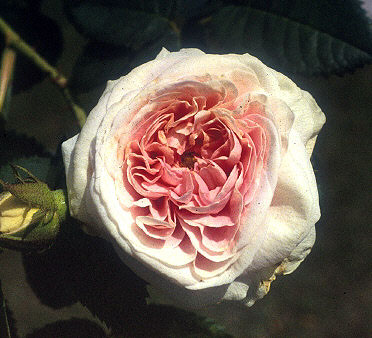
Felicite Parmentier. Alba. (1834) 4-5 feet. One annual flowering. (fay-lee-see-TAY par-mon-TYAY) Zones 4-9.
A big plant with grey green foliage, its canes weighted over with
clusters of from 3 to 5 clear, pale pink flowers which open with
a swirl of many small petals, then reflex
to make a 2 1/2 inch ball showing a green eye at the center.
Deliciously perfumed and one of the loveliest of the charming Alba
roses. Excellent rose for hot, dry climates. Jim Dickinson,
Surry, Maine, thinks I shouldn't restrict it to hot, dry climates, when
he says, “I have planted Felicite Parmentier in a group along the south
side of an ocean front home in Blue Hill, Maine, and it has withstood
the wind and cold, coming back with flowers even after a winter with
the temperature dropping to minus 20 degrees.”
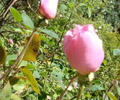
First Love. Hybrid Tea. (1951) 3-5 feet. Blooms repeatedly.
Vigorous, tall and regal plants produce a profustion of the most beautiful, long, spiraled buds of any Hybrid Tea I know . . . the inside of the petals dawn pink, reverse deeper pink. The buds slowly and dramatically unfurl . . . beautiful at every stage . . . and have a tantalizing, sweet fragrance.
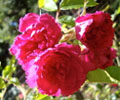
F.J. Grootendorst. Hybrid Rugosa. (1918) 5 feet. Blooms repeatedly. Zones 3-9.
This rugosa hybrid is a good grower with a bushy, upright habit with
clusters of small, crimson, carnation-like flowers. Though lacking in
fragrance, it is easy to grow with good disease resistance and tolerant
of seaside conditions.
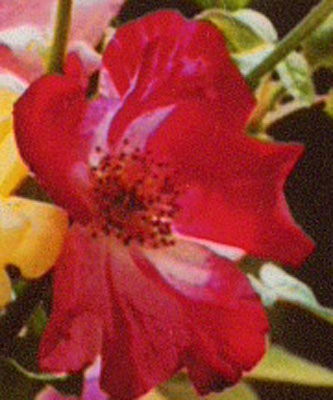
Fourth of July, Climbing. Large Flowered Climber. 1999. 10-14 feet. Repeat bloom. Zones 5-10.
A free flowering vigorous plant with sprays of long lasting, large,
semi double blooms striped velvety red and bright white. Glossy
green foliage, vigor, and hardiness add to the fortitude of this
variety. It is also the first climber to take the coveted AARS
award in 23 years. A visitor to the garden remarked that in twenty
years of gardening with roses, this rose has given her the most
enjoyment of all.
Fragrant Cloud. Hybrid Tea. (1967) 4-5 feet. Repeat bloom. Zones 5-10.
In 1963 Ned Irish wrote me from London...“Flash! I popped in the Autumn
Show of the Rose Society on Harry Wheatcroft’s adjuration not to miss
the rose of the Century. It's Tantau’s newest: Harry named
it Fragrant Cloud because of its pronounced true rose scent.
Color? Hmm. When it won a Gold Medal the citation called it
cinnabar. Harry calls it vermilion. It is undeniably a deep
coral-rose...like a half cup of vermilion- to which a half cup of
shocking pink and a generous dash of cream has been added." There
are times when it appears some coffee has been added, too." All this
glorious fragrance and color is in large, beautifully formed, many
petaled blooms on a vigorous plant with lush bronzy foliage.
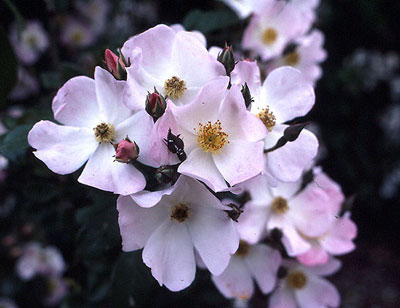
Francis E. Lester. Hybrid Musk. (1946) 12-20 feet. One long bloom. Zones 6-10.
Named after an early rose conservationist and one of the founding
father's of this rose business. This very fragrant rose with trusses of white
singles edged with pink, like apple blossoms which leave small orange hips,
can be easily trained along a fence, up a tree, or over an embankment. The
scent travels a wide area.
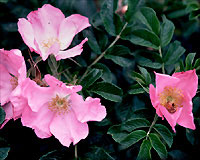
Frau Dagmar Hastrup. Rugosa. (1914) 2-3 feet. Flowers repeatedly. Zones 3-9.
The very epitome of simple beauty. Three inch, five petaled, satiny, clear pink
flowers shine like stars from the handsome rugose foliage. Large red hips form
when the petals fall and the plant goes right on blooming. The hips on this Rugosa
are quite exceptional - do not cut off the bloom as you do other types of roses or
you will sacrifice them.
Bees always congregate around the Rugosas, and I rarely can take a photo of
Frau Dagmar Hastrup without a bee in the middle of the flower - wonderful fragrance
is the attraction.
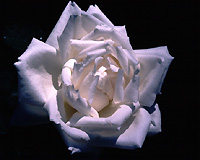
Frau Karl Druschki. Hybrid Perpetual. (1901) 4-6 feet. Flowers repeatedly. Zones 5-10.
(DREWSH-key)
This is the great white lady of rosedom! Sometimes known as the “Snow Queen”
because of her pure whiteness and queenly form. Free flowering, tall growing and for
all round virtue and beauty combined, still unbeatable in white roses.
John E. Hogan, Los Angeles, wrote, “Frau Karl Druschki deserves a solitary show
place in the center of a large yard...75 magnificent blooms and almost as many buds on
her strong branches.”
General Jacqueminot. Hybrid Perpetual. (1853) 4-5 feet. Flowers repeatedly.
(ZHOK me-noh)
“General Jack” is praised in every book that mentions Hybrid Perpetuals; from Dean Hole's
“Book About Roses”, published in 1865 . . . “A glory and a grace, its petals, soft and smooth
as velvet, glowing with vivid crimson, and its growth being free and healthful.”
This is another of the Hybrid Perpetuals that benefits by “pegging” the long canes down >
to increase the bloom. Can be treated like a climber when planted along a fence, and is also
good as a free-standing shrub as its canes are strong and vigorous.

Gertrude Jekyll. Shrub. David Austin. (1986) 4-6 feet. Flowers repeatedly. Zones 5-10. (GEE-kuhl)
Voted the most popular “English Rose” in England, Gertrude Jekyll has large
double quartered clear pink blooms with a rich damask fragrance that wafts through
the air. The blooms are borne on sturdy stems and open well without balling even
in wet weather despite its large amount of petals. Prune regularly to encourage
more flowers as it blooms on new wood. It grows fairly upright and is less sprawling
than most David Austin roses and it is fairly disease resistant. Gertrude Jekyll is a
direct descendent of Comte de Chambord which it resembles closely.
In hot climates, this rose can climb to 9 feet.
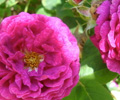
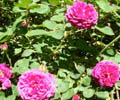
Gipsy Boy. (Zigeunerknabe) Bourbon/Rugosa. (1909) 5’h-10’w. One annual flowering. Zones 4-9.
(tzee-GOY-nur-knob)
The rose everyone wants when they see it in bloom as they enter the garden
gate on their way to the potted roses for sale. The wide and full shrub is covered
in small clusters of fragrant, fair-sized double flowers of deep crimson purple, with
white in the center and yellow stamens slightly hidden. Shade tolerant, as well as suited
to poorer soil conditions, this is a splendid shrub with orange red hips in the fall.
With it's arching (prickly!) stems, Gipsy Boy can be trained as a small climber.

Climbing Golden Showers. 1956. 12-14 feet. Blooms repeatedly. Zones 4-9.
Climbing Golden Showers has abundant clusters of daffodil yellow 4" blooms
with lightly fringed petals which open to red tipped stamens. This award winning
climber has a sweet lemon fragrance. In hot sun open flowers fade
to ivory but in partial shade flowers will be fewer but will hold their yellow color.
Golden Showers is good for pillars, trellises, walls and fences, and as cut flowers.
It is somewhat disease resistant and semi-hardy and blooms on old and new wood.
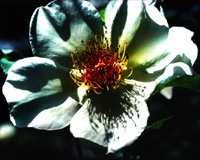
Golden Wings. Shrub. 1956. 5-6 feet. Flowers repeatedly. Zones 5-10.
Very large (4-5 inch) single yellow, long pointed buds open with prominent stamens
in the center. Lightly fragrant, profuse blossoms come throughout the spring and into
fall on handsome bushy plants that are very hardy.
We have had many requests from customers and garden visitors to add this delightful
rose to our listings.
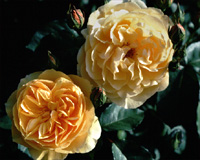
Graham Thomas. David Austin. 1983. 6 feet. Yellow. Fragrant. Repeat bloom. Zones 5-10.
Named for the most knowledgeable rosarian in the world today, this rose is a fitting
tribute. David Austin, the hybridizer, has added other varieties to an ever growing list
of "Heritage Roses", bringing new color tones and fragrances to the world of roses,
but this gorgeous variety is incomparable.
A color difficult to describe, it all begins with buff/peach tight buds that open to
cupped flowers of deep, creamy yellow. A pervading fragrance is apparent while
standing six feet from the plants - wonderful! The plants grow tall, with stems to match,
that produce multiple stems of continuous flowers. I hear that in England the plants
are many times used as climbers, with the long canes pegged down in an arched
position, thereby increasing the number of blooms. Good disease resistance.
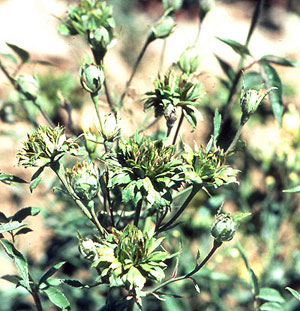
Green Rose. Rosa Chinensis Viridiflora. (1843) To 8 ft. Green. Repeat bloom. Zones 7-10.
Will Tillotson wrote of Green Rose, “Certainly this rose is an interesting novelty
. . . but for beauty, it has only ‘ugh!’ It’s flowers are no flowers at all but a strange
and quite unexplained freak of foliage; the green buds open to double, leaf green
‘flowers’, edged with bronze.” Striking in flower arrangements.
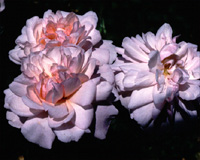
Gruss an Aachen. Floribunda. 1909. 2-3 feet. Repeat bloom. Zones 5-10.
(groose ahn AH-ken)
In all the world, there is no Floribunda to compare with this
one! My favorite of all, this rose has attributes of no other.
The strong, spreading plant grows no more than three feet tall, and
produces the most luscious shell pink to creamy white buds and flowers
imaginable. In Europe Gruss an Aachen is described as creamy
white and the combination of pink and cream makes a beautiful picture
in the garden panorama. The well shaped buds open to wide, very
double blooms that are flat-topped and 3-5 inches across.
Fragrant. An excellent hedge subject since the plant never grows
long, ungainly canes above the other growth.
Top
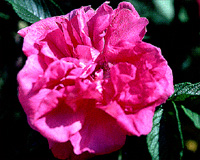
Hansa. Rugosa. (1905) 5 feet. Flowers repeatedly. Zones 3-9.
A tall growing Rugosa with typical thick, ribbed foliage. The double
flowers are vibrant purple red and have a sweet fragrance accented with clove.
Large, red hips ripen after petals fall.
Wrote Wendy Bie, Rolla, Missouri, “Just wanted to put in a good word
for Hansa...came through a month of sub-zero temperatures followed by
severe black spot infestation unscathed. It was the only rose that didn't die back,
the first to leaf out, and the first to bloom...a paragon of good health and hardiness
beside being beautiful and fragrant.”
Happenstance. Hybrid Bracteata. (1950) 2-3 feet, width to 4'. Repeat bloom. Zones 7-10.
This is 'Baby Mermaid' according to Peter Beales who says this rose was brought to the U.S. from the U.K This sport of Mermaid is a valuable shrub or ground cover that will grow to 4 feet wide and 2-3 feet high. The light yellow single blooms have a strong fragrance and bloom in flushes throughout the season.
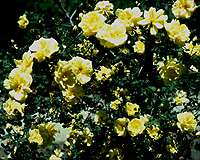
Harison’s Yellow. Hybrid Foetida. (1830) 6-8 feet. One annual flowering. Zones 3-9.
A native of Asia and a member of a large family of yellow species roses. The
flowers are brilliant yellow, about 2 1/2 inches across, and are cupped and double.
Among the most fragrant of its group, the blossoms are borne on short stems
all along the very thorny canes. The foliage is small and fernlike.
Often called the “Pioneer Rose” because of the stories of plantings all along
the 49’er Trail where it still exists, it is a rose of history.
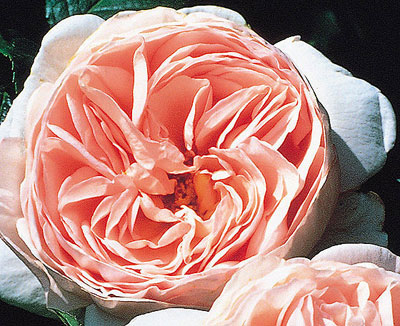
Heritage. David Austin. 1984. 4-5 feet. Shell Pink. Fragrant. Repeat bloom.
Zones 5-10.
A robust grower with a bushy, upright habit which has cupped blush pink flowers
borne in clusters with a rich scent that is a blend of myrrh and lemon. This fairly
disease resistant plant is a fine addition to beds and borders, or makes a wonderful
hedge with a long season of cut flowers. The foliage is dark green and semiglossy.
Hot Cocoa. Floribunda. (2003) 4 feet. Flowers repeatedly. Zones 5-10.
Burnt sienna and warm orange tones grab people's attention, but the glossy foliage and fragrant flowers convince them they want to add this rose to their collection. Vigorous bloom and disease resistance make this a popular modern rose variety.
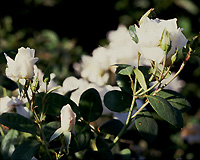
Iceberg. Floribunda. (1958) 4-5 feet. Flowers repeatedly. Zones 4-9.
This is the finest white Floribunda I know. Nothing can surpass its
cleanliness, constancy or pristine quality of bloom. The white flowers
have a blush pink tone on the buds in cool weather, but otherwise, they
are snow white.
Dorothy Spencer, Kentfield, California, says, "Iceberg has created a
sensation here on our street - it can be seen from the boulevard below us
and we have many people stop to ask us about it." And, from Mrs. W.
L. Embree of Prairie Village, Kansas, "Iceberg is the best white rose I've
found for constant bloom and bouquets."
Top

Iceberg, Climbing. (1968) 8-10 feet. Flowers repeatedly. Zones 4-9.
The climbing sport of the wonderful bush Iceberg, this is identical in
bloom, foliage and disease resistant qualities, except that it is larger in every
way. Best when planted against a fence so that its canes can be arched in a
fan position - it is so prolific in bloom that you will be able to cut large bouquets
for the house, yet seldom see where you have cut.
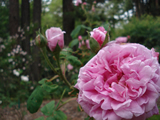
Jacques Cartier. (Marquise Bocella) Portland. (1842) 2-4 feet. Flowers repeatedly.
(JOK-car-TYAY) Zones 5-10.
Whether Portland or Hybrid Perpetual, this rose is worthy of any garden or
rose show. It is best to enter it in a rose show under the name "Marquise Bocella"
as you can use the date eligible for Dowager Queen (before 1867). The date given for
Jacques Cartier is 1868, not eligible. The name, "Marquise Bocella", has been
officially adopted by The American Rose Society.
A compact, erect plant with closely spaced, light green foliage that encircles the blooms...
Graham Thomas calls it, "that high shouldered look." Clear pink, 3-4 inch flowers with
an intense fragrance, have so many petals they make me think of fluffy powder puffs.
One of my favorite roses in the garden and for bouquets...and very long lasting.
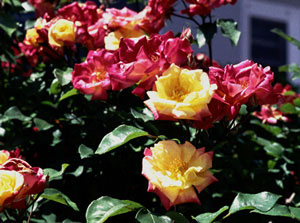
Joseph's Coat, Climbing. Large flowered climber. (1964) 6-8 feet. Blooms repeatedly.
Under the guidance of Armstrong's Roses, many wonderful roses were hybridized, this one by Herb Swim. Beautiful clusters of 3-4 inch blossoms in yellow, rose and red cover the breathtaking plant most of the year. I've seen this rose in the driest, hottest conditions of the San Joaquin Valley and it still makes me gasp. I've long wanted to add it to our catalog so more of you can enjoy it.
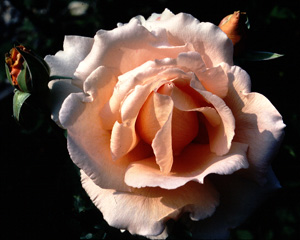
Just Joey. Hybrid Tea. (1972) 3 feet. Blooms repeatedly. Zones 5-10.
It took this lovely rose over ten years to get across the Atlantic Ocean
from England, where it was hybridized, and it created a sensation the moment
it arrived. Extremely fragrant, very large, (7 inch), double blooms. Fantastic
creamy buff/orange color always stops the foot traffic in our garden.

Kathleen. Hybrid Musk. (1922) 6-15 feet. Blooms repeatedly. Zones 5-10.
An unusual and unforgettable rose! Vigorous and healthy with disease
resistant foliage on a plant with upright growth - ideal for training into a
tree form. Large clusters of tiny, pointed, china pink buds and single, blush-white
flowers with stiff yellow stamens that closely resemble apple blossoms, so richly
perfumed they attract the bees. The blossoms drop cleanly and orange hips, in large
clusters, form. As it blooms repeatedly without removing the hips, there are flowers
and hips on the plant late in the fall. Blooms well in slanted and filtered light.
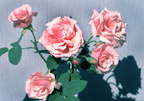
Kathleen Harrop. Climbing Bourbon. (1919) 6-8 feet. Blooms repeatedly. Zones 5-10.
This rose has grown in our garden for many years and was once listed in
our catalog. A sport of Zephirine Drouhin, the double, pale pink blossoms are
identical to its relative, except for the tone of pink and have the same wonderful
fragrance. Planted side by side the colors complement one another, an their
thornless canes make them a desirable addition to deck plantings and along
walkways.
Writing in November, Mary Yee, of Silver Spring, Maryland, wrote, “There
was almost no evidence of disease at any time in the season, and now the plant
remains clothed in leaves when black spot has defoliated most of the other roses
in the garden.”
Kazanlik - See
Rosa Damascena Trigintipetala (Kazanlik)
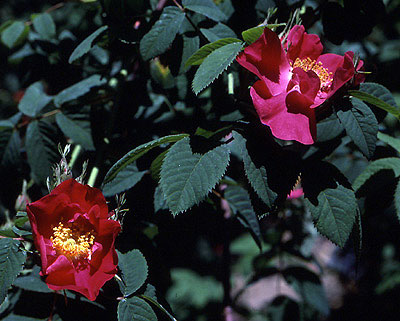
Rosa Damascena Trigintipetala. (Kazanlik) Damascena. (Prior to 1700) 3-4 feet.
One annual flowering. (. . . dahm-ah-SAY-nah tri-gin-ti-PET-ahla) Zones 4-9.
Urn-shaped, shiny red hips adorn the upright, almost thornless plant in fall - one
of my favorite additions to Thanksgiving arrangements. The spring flowers are cherry
red, have soft “wavy” petals and a heavy perfume. Very clean, disease free plant.
Historically important in the collector’s garden.
Excellent for potpourri and attar of roses preparation as the color and perfume stay
with the petals for a long time.
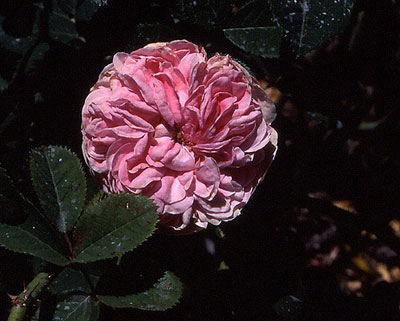
Konigen von Danemark. (Queen of Denmark) Alba. (1826) 4-5 feet.
One annual flowering. (KUR-neekin fone DANE-uh-mark) Zones 4-9.
This, like all Alba roses, is extremely weather tolerant. The clarity of the color
of pink in the flowers is perfectly complemented by the blue-green foliage of the plant.
The buds of the 3 inch double flowers have fair size outer petals, quartered centers
when fully open, and are intensely perfumed.
This is a good rose to use as a background in a mixed bed of perennials or as
a hedge - also wonderful for potpourri. Will tolerate poorer soil and is shade tolerant.
La France, Climber. Climbing Hybrid Tea. (1910) 8-10 feet. Blooms repeatedly. Zones 6-10.
A climbing sport of the bush La France, and like its parent except in increased size of plant and number of blooms. Even though classed as a climber, it is, like many of the climbing Hybrid Teas, very effective used as a tall shrub, pruned to five feet, making a rounded shrub with foliage and flowers from the ground up. Such roses! The light pink blooms have a beautiful form, make good cutting roses, and have a strong fragrance.
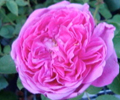
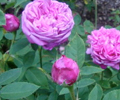
La Reine. Hybrid Perpetual. (1842) 4 feet. Blooms repeatedly. Zones 5-10.
This is one of the earliest Hybrid Perpetuals recorded. For a span of years it literally
disappeared, but was finally found in France in the early 1900s.
With shorter growth patterns than many of its relations, La Reine is quite desirable for the modern garden. Cupped blooms hold many petals of deep silvery rose, sometimes quartered in the centers, and extremely fragrant. A wonderful cutting rose, and a good candidate for the Dowager Queen Award in rose shows.
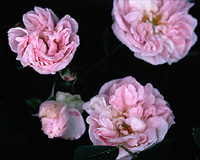

Lavender Lassie. Hybrid Musk. (1958) 6-10 feet. Blooms repeatedly. Zones 5-10.
Michael Donnally, of New York City, wrote about Lavender Lassie, “At the
top of the stairway her blooms are seen against the ocean. Whether the sea is
slate grey, green or aquamarine, those cool pink blooms work beautifully
with the watery background. Beginning in late May, the candelabras of her buds
show their pink and open to perfume the air for the rest of the summer. She is a
“doer”, a good self-groomer with her blooms, vigorous with clean, medium
green foliage. Thus far, she has required no spraying for pests or disease.”
Lavender Lassie has upright growth to 5 or 6 feet, then trailing growth to
10 feet with few thorns, making it a good subject for training along a fence, or
trailing over a low wall.
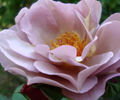
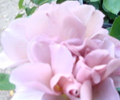
Lavender Pinocchio. Floribunda. (1948) 2-3 feet. Flowers repeatedly.
An exuberant, healthy plant in growth and bloom . . . its clusters of fragrant,
large, double flowers are saffron to brown to lavender tones . . . among the rarest
shades in rosedom. Another of those individuals one would never mistake for
something else. For those of you who appreciate the subtle and uncommon things
in life . . .
Brigitte Pitkin, Seattle, Washington, wrote us, "I wanted to let you know I am
tickled lavender by your Lavender Pincocchio . . . if I had an extra inch left in
my yard, I surely would plant another one!"
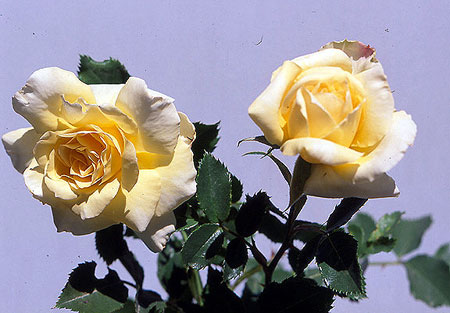
Leverkusen. Kordesii. (1954) 8-10 feet. Blooms repeatedly. Zones 5-10.
(lay-fur-KOO-zun)
One of the most beautiful climbing roses I know, with glossy foliage and sprays
of long pointed buds and large, crisp looking double flowers of clean, light yellow,
with a fruity fragrance. They have such a special quality Mrs. Lee Strong wrote
from Kalamazoo, Michigan . . . “I ‘flipped’ over the first bloom, and it’s covered
with them.” . . . and Robert Kimberly, Rowe, Massachusetts says . . . “The flowers
are a poem in petals.”
This is similar to Dortmund, but much fuller and yellow - a wonderful landscape rose.
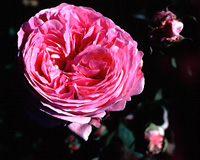
Louise Odier. Bourbon, 1851. 5 ft. Deep pink. Blooms repeatedly. Zones 5-10.
(oh-dee-EIGH)
Deep pink, very double, cupped blooms are reminiscent of those of La Reine
Victoria, but are more flat and wide when fully open. The plant has the fine light
green foliage of the Bourbons, compactly arranged. In flower from early June
to October, with a pungently strong fragrance. A good-keeping cut flower.
From John Hand, Tustin, California, came this good comment, “Louise Odier
has been in my garden for two years and has been a constant source of enjoyment -
she is almost always able to supply a bouquet for a special occasion, and elicits
many exclamations over her beauty and fragrance.” “To take in her scent,
just walk past her,” says Claire Crockett of Cleveland, Tennessee...“One would
think she had been dipped in the most expensive perfume. Her tissue paper
blooms are full and round - she is truly a fun rose.”
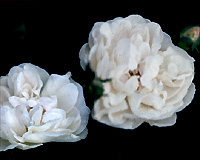
Madame Alfred Carriere. Noisette. (1879) 12-20 feet. Flowers repeatedly.
(car-ee-AIR) Zones 5-10.
Double 3-4 inch blossoms of white, flushed with pale pink tightly curled petals
in the center. Intensely fragrant, and more hardy than most of the Noisettes.
A graceful large shrub to plant at the top of a gentle slope, but equally good when
used as a climber. Constantly in bloom in milder climates, and a rose to admire in
any planting - we have it planted below our deck at the old office. The deck is
10 feet off the ground, the railing is 3 feet high, and Madame Alfred has 6 foot canes
above that - I'd say this rose is a good candidate for tree climbing! Wherever it is,
planted or in a bouquet, it is the rose you will never forget.
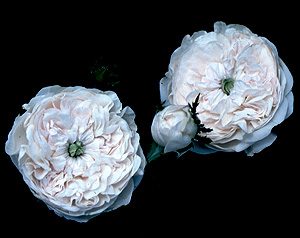
Madame Hardy. Damask. (1832) 4-6 feet. One annual flowering. (are-DEE) Zones 4-10.
From tight buds with beautifully flared sepals, through all stages to
the fully open, large, very double, flat snow white flower with a pronounced green
point at the center, Madame Hardy is a thing of rare beauty. The blooms are in clusters,
the center buds opening first, and often when partly open there is a flush of pink,
quickly changing to pure white, exquisitely perfumed. A sturdy bush with
canes that benefit from pegging or shortening to promote side shoots and blooms.
Robert Janes, Ionis, Michigan, says, "Madame Hardy is a study in
feminine elegance."
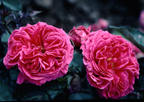
Madame Isaac Pereire. Bourbon. (1880) 4-6 feet. Magenta. Flowers repeatedly. Zones 5-9.
(ee-SOCK pay-RAIR)
Possibly the most powerfully fragrant of all roses. The flowers are large,
of intense rose-madder, shaded magenta, bulging with rolled petals, quartered
and opening to a great saucer-face. Big, bold foliage and a fine bush. “When
it is well grown, on a good deep soil, it has no peer”, writes Graham S. Thomas
in his book, “The Old Shrub Roses”. Such a fine description from one who
is familiar with more old roses than any other, is strong endorsement.
Another endorsement came from C.B. Waldron, of Henderson, North Carolina,
who said, “Madame Isaac Pereire did not bloom, she exploded! More than 25
flowers at at time in all stages of bud and bloom!”
Marchioness of Lorne. Hybrid Perpetual. (1889) 4-5 feet. Fulgent Rose. Flowers repeatedly.
This is a creation of William Paul, who grew roses for sale in Britain in the mid 1800s, and at that time published a book, The Rose Garden. I have the tenth edition, published in 1903. In it he lists 226 varieties of Hybrid Perpetuals which were as popular then as Hybrid Teas are today. His description of his own creation, Marchioness of Lorne . . . "Flowers fulgent rose color, full, finely cupped. The blossoms are freely produced throughout the season, and are deliciously fragrant." To be truthful, I had to look up the word fulgent in the dictionary, and found no other could so well describe the glowing rich color. Dorothy Stemler, 1976 Roses of Yesterday & Today catalog
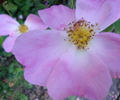
Marguerite Hilling. Shrub (1959) 3-5 feet. Flowers repeatedly.
A bright pink sport of the great shrub rose, Nevada. In the many years it has grown
in our garden the plants are 4 feet high and 5 feet through, with gracefully arching canes
covered with large 4 to 5 inch semidouble flowers in cycles of profuse bloom, and in
between there are always some flowers. Its sweet fragrance is attractive to bees. One of the
most beautiful shrubs we have and it blooms extravagantly.
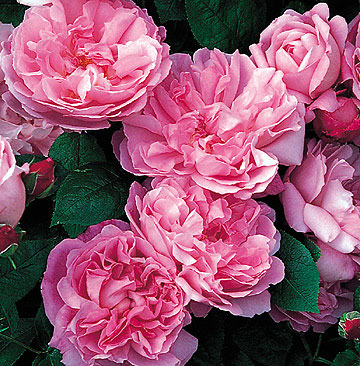
Mary Rose. David Austin. 1983. 5 feet. Pink. Fragrant. Repeat Bloom.
A strong tall grower with clear pink roses in the appearance of damask roses
and with a damask fragrance. It tends to send out long tall shoots, in the habit of
a robust twiggy shrub, and foliage is medium green and fairly disease resistant.
Mary Rose is one of the first and last to bloom. David Austin named the rose in
honor of the recovery of Henry VIII’s flagship from the Solent, after more than 400 years.
More suitable to a larger garden, unless pruned regularly, as it can grow quite tall
with neglect.
Mermaid. Hybrid Bracteata. (1918) 15-25 feet. Yellow. Repeat Bloom. Flowers repeatedly. Zones 7-10.
One of the outstanding characters of rosedom, and one of the most beautiful . . . abandoned by most commercial nurseries for its cantankerousness in the growing field and the great cost of producing plants of it. It is equally efficient whether planted as a ground cover or climber . . . always in bloom with 5 inch, soft yellow (almost white in hot weather) single flowers with prominent gold stamens. Wild rose fragrance, attractive to bees . . . drops its spent petals so the plant, with glossy leaves, always looks clean. This was Claude Monet's favorite climber!
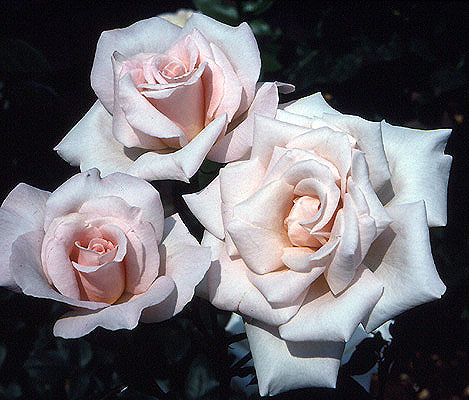
Michelle Meilland. Hybrid Tea. (1945) 3 to 4 feet. Blooms repeatedly.
This is one of those Hybrid Teas that has a color difficult to describe - pale pink,
translucent quality, with overtones of cream and apricot. Long strong stems,
vigorous growth, prolific bloomer - what more could you want in a garden rose?
In the fall of the year the blooms are more pale apricot than pink, but always have the
classic shape of the exhibition rose, and it has been the winner of many blue ribbons.
Says Nancy Harper, Winston-Salem, North Carolina, “Michelle Meilland has as much
color and beauty as anything we grow. The colors at any time of the season blend
well with so many roses, old and new, that you can always count on this rose
to brighten up a mixed bouquet or make a stunning arrangement of its own.”
Writes Mrs. Lois Corrill from Boulder, Colorado . . . “I think I must always have
Michelle Meilland. It is something dreams are made of.” And Jeanne Marshall, who
put in many years here at Roses of Yesterday and Today, exclaimed, “They look like porcelain!”
Miniature Mermaid/Happenstance. Hybrid Bracteata. (1950) 2-3 feet, width to 4'. Repeat bloom. Zones 7-10.
This is 'Baby Mermaid' according to Peter Beales who says this rose was brought to the U.S. from the U.K This sport of Mermaid is a valuable shrub or ground cover that will grow to 4 feet wide and 2-3 feet high. The light yellow single blooms have a strong fragrance and bloom in flushes throughout the season.
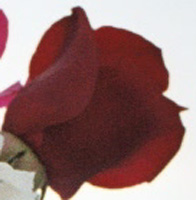
Mister Lincoln. Hybrid Tea. (1964) 4-6 feet. Flowers repeatedly.
Zones 5-10.
A beautiful rose for the formal garden, or for anywhere you would like
to have reliable deep red roses which are also fragrant and excellent for cutting due
to their long strong stems. Red-black buds open to beautiful 4 1/2 inch to 6 inch velvety red
long lasting blooms. Does well in beds and borders and has been disease
resistant in our garden here in the redwoods.
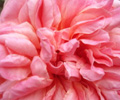
Monsieur Tillier. Tea. (1933) 2-3 feet. Flowers repeatedly.
Definite copper overtones shade the edges of the petals and, as they eye descends to the center of the blossom, the colors change to gold overshot with pink.
The petals laid one over the other, like tiles on a roof – one thinks of a carnation, as each petal is clearly defined in the very double bloom.
The plant puts the picture together by being well foliated with bronzy green foliage, lightly tinged with red tones when young.
Very fragrant with a pungent tea rose perfume. A really lovely old tea rose.
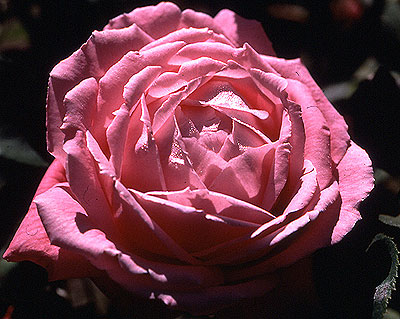
Mrs. John Laing. Hybrid Perpetual. (1887) 5-6 feet. Flowers repeatedly. Zones 4-10.
One of the best known and most popular of the big, pink, richly fragrant Hybrid
Perpetuals. Winter hardy just about anywhere . . . profuse and recurrent bloom.
Says master word artist, Dean Hole . . . “Not only in vigor, constancy and abundance,
but in form and feature, Beauty's Queen.”
One November, Mrs. George E. Shields, Alexandria, Virginia, wrote . . . “Mrs.
John Laing has been literally covered with buds and flowers for the last month. The
other day there were a dozen huge, fragrant blooms, making it look like a big bouquet.”
And Mrs. Jonathan L. Brusch, of Newtown, Pennsylvania, said, “Across the kitchen are
four blossoms from Mrs. John Laing. The fragrance makes me want to sit her 24 hours
a day!”

Mrs. Sam McGredy, Climbing. Hybrid Tea. (1937) 7-8 feet. Spring and intermittent flowering.
We often say it is better to buy the climbing sports of the Hybrid Teas when available, since they usually have more vigor than the bush and the bloom obtainable is ten-fold. This is especially true of Mrs. Sam McGredy. A perfectly lovely blend of deep scarlet/copper/orange, with shades of yellow in the base of the petals. The blossoms are fully double, exhibition type, with a lovely light fragrance.
Top
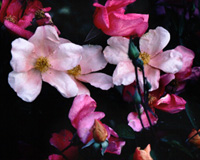
Mutabilis. Rosa Chinensis Mutabilis. (Prior to 1896) 5-8 feet. Flowers
repeatedly. Zones 7-10. (moo-TOBB-il-iss)
A species rose from China, but there is no exact recorded date of its
discovery. The sun lighting up a plant of Mutabilis, with its red leaves and
canes, is a thrilling picture. One sees color in the play of light and shadow
from copper to red mahogany. The 3 inch single flowers in clusters open
yellow, then turn pink and gradually deepen to dark red...and they are fragrant.
Sylvia M. Plytas, of Novato, CA, wrote, "I put Mutabilis at the side of
the house where it can be seen from the dining room. It has been a constant
bloomer in all seasons. I personally enjoy haw the colors change from day
to day and hour to hour - it demands I glance at it often!"

Climbing New Dawn. Large Flowered Climber. (1930) 12-15 feet. Flowers
repeatedly. Zones 4-9.
A sport of Dr. W. Van Fleet, with all its parent's attributes, plus repeat bloom.
Glossy disease free foliage, which is dark green, makes a perfect foil for the pale pink,
fragrant flowers. Blooms more in clusters than Dr. W. Van Fleet, but with the same
long stems.
Elizabeth Robinson wrote us, "Just a note to say that we have had New Dawn in
our garden for many years, and it is extremely hardy in our very cold winters.
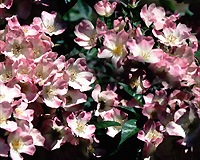
Newport Fairy. Rambler. (1908) One long annual bloom. Potted Only.
Not available for shipping.
Whether trained along a fence or braced against a post, the rate of
growth and the amount of bloom on even a young plant is astounding.
One of the few single roses that keeps very well in flower arrangements.
The blossoms are deep pink on the edges with white toward the center
surrounding bright yellow stamens. Our plant in the display garden is now
three years old and is one of the most exciting roses there. I stopped
counting when I got to 60 stems of bloom, and there were almost as many
again if I had kept counting. A very hardy variety too.
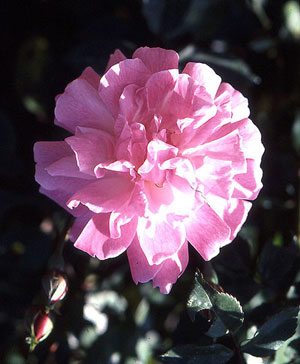
Old Blush. China. (1752) 3-5 feet. Flowers repeatedly. Zones 7-10.
The date given for this variety is when it was first brought to Europe from
Calcutta, but it was brought to Calcutta from China long before that. Many people
believe it to be the rose Thomas Moore wrote of in his song, “The Last Rose of
Summer”. One of the first roses to bloom and one of the last “left blooming
alone”.
The semidouble 2 1/2 inch clear pink flowers are borne in clusters, the color deepening
in the sun . . . a characteristic of most China and Tea roses. The fragrance is fresh and
sweet. One of the main attributes of this lovely shrub is its ease of care - it will have a
first flush of bloom, then put on some growth and bloom as much again - just shape
up the plant after each bloom, and do not prune severely - its beauty is in the profusion
of bloom on a medium size plant.
Olympiad. Hybrid Tea. (1984) 3-5 feet. Flowers repeatedly. Zones 5-10
With an ARS rating of 9.1, and abundant 4 to 5 inch true red
blooms borne singly or in clusters on long, sturdy stems, this rose is a
winner for both cutting and exhibition and is very long lasting. We chose
this red rose for the bouquet for the catalog this year, and it was
the last rose standing in the bouquet, ten days later. Little fragrance.
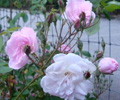
Parson’s Pink China. Old bush. (1943) 3-10 feet. Repeat Bloom.
This rose has been grown in China for over a thousand years. Semi-double to double, clusters of pink buds open cupped to flat, and blush more pink with age, rather than fading like other species do. The bush grows easily in various conditions and needs little pruning. The light green, disease resistant foliage is shade tolerant, and the flowers bloom all season long.
A famous nurseryman, Tom Smith, of Northern Ireland, claimed this rose to be the “Last Rose of Summer” that the Irish poet Thomas Moore wrote about, as it has been known to have blooms at Christmas.
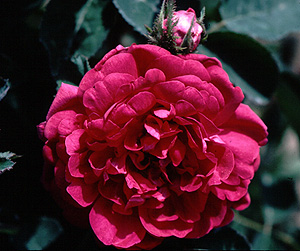
Paul Neyron. Hybrid Perpetual. (1869) 5-6 feet. Blooms repeatedly.
(pol-nay-ROHN) Zones 5-9.
I am often asked, "Do you have a cabbage rose?" When I explain Centifolia roses area sometimes
commonly called cabbage roses, and name a few, I'm told, "No, what I want is a huge, very fragrant rose
pink bloom that has hundreds of petals." Then I say, "You must mean Paul Neyron."
Simon Roberts, Shawnee Mission, Kansas, took me to task about the foregoing description of
Paul Neyron, saying, "With its beautifully proportioned cup shape, rich colour and unique scent full
of citric overtones, I am often inclined to consider it the most perfect rose I encountered - and I say
that being familiar with the contents of Sackville-West's gardens at Sissinghurst."
Peace. Hybrid Tea. (1945) 4-6 feet. Flowers repeatedly. Zones 5-10.
No two blooms exactly alike, Peace's very double, large 5-6 inch blooms,
vary in shades of pale to golden yellow with shades of apricot and pink
and have a mild fragrance. A very vigorous grower, it delights with variations
in color with changes in temperature and light, and is a good choice for beds
and borders. Borne singly and in clusters, it's strong stems make it a good
choice as a cut flower. Glossy green foliage and fairly disease resistant.
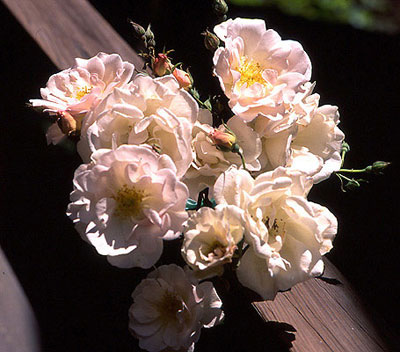
Penelope. Hybrid Musk. (1924) 5-8 feet. Flowers repeatedly. Zones 5-10.
Through Graham Thomas, Penelope has been in our garden for several years.
Ophelia is one of its parents, which accounts for its exquisite soft coloring . . .
salmon buds that open creamy white and in cool weather, palest pink. The large
clusters of 2 1/2 to 3 inch flowers and buds have a musk fragrance, and the foliage
is excellent and glossy. The fall hips are unlike any I have ever seen . . . pale,
apple green, changing to coral pink . . . one of the most beautiful features of a
very beautiful rose.
Mrs. David Albrecht, San Jose, California, wrote, “Just wanted to tell you
Penelope is the most beautiful rose in our garden. It is always covered with
blooms . . . and requires little or no care.”
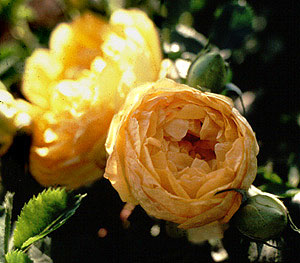
Persian Yellow. Rosa Foetida persiana. (Before 1837) 5-6 feet. One annual flowering. Zones 3-9.
A famous parent of today's yellow roses, and one which should be in every
collector's garden. Chrome yellow, very double flowers on short stems bloom
all along canes that are the reddish brown common in this class of roses. Moder-
ately thorny. The licorice scent is also typical of the class, the same as Austrian
Copper and Harison’s Yellow, which are both close relatives.

The Pilgrim. Shrub. David Austin. (1991) 4-5 feet. Zones 5-10.
Beautifully formed, large, quartered soft golden yellow blooms open flat
with many small petals, that are paler yellow around the edge. The shrub can
climb in temperate climates to 10 feet but it can be kept shorter if pruned after
it blooms. The growth is strong, healthy, and upright. The leaves are medium
green and blackspot and rust resistant, although it can be susceptible to mildew.
The blossoms exude a strong fragrance that is a blend of tea and myrrh.
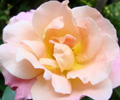
Pink Pillar. Brownell Pillar. (1933) 7-8 feet. Blooms repeatedly.
There are many fragrances in the rose world; spices, damask, musk, banana and even licorice, but this rose has a distinct citrus perfume.
Beautiful, long lasting blooms with 16-20 petals, come 3-6 to a stem, are edged with pink scalloped rims, and are in every shade of pink, coral and orange.
This comment came from Kathleen Miller, Zillah, Washington, "Pink Pillar, which you sent as a substitute, is a beautiful coral-rouge pink in our climate, and just dazzling!"
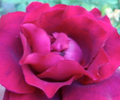
Prince Camille de Rohan. Hybrid Perpetual. Shrub. (1861) 5-6 feet. Flowers repeatedly. (pranhs ka-MEEL duh ro-ANH).
“A handsome and richly perfumed prince of roses, dressed in royal velvet!” A farfetched exclamation, but the large full-bodied blooms of deep velvety crimson justify it. Strong and hardy plant . . . has everything one desires in a dark red rose. J. D. Sackett, Oklahoma City, Oklahoma, wrote, “I want to mention to you about Prince Camille de Rohan – its first blooms were 5 ½ inches across! Beautiful, eye-pleasing, dark bluish red – yes, a prince of red roses!”
Queen Elizabeth. Grandiflora. (1954) 5 feet. Blooms repeatedly. Zones 5-10.
Named for England’s beloved monarch, Queen Elizabeth is a vigorous grower with
upright growth and long strong stems that make it a good cutting rose for a tall vase.
Some list this rose as a Floribunda, in England in particular, as the blooms sometimes
come in clusters. Blossoms are medium pink, large, double, high centered, with a moderate
tea fragrance, and come in flushes throughout the season.
Queen Elizabeth makes a good hedge but it can also climb to 8 feet if you allow it.
Prune lightly to encourage more bloom. A longtime favorite for its bloom color and
form, as well as its vigor and fairly good disease resistance.

Queen of Denmark. (Konigen von Danemark) Alba. (1826) 4-5 feet.
One annual flowering. (KUR-neekin fone DANE-uh-mark) Zones 4-9.
This, like all Alba roses, is extremely weather tolerant. The clarity of the color
of pink in the flowers is perfectly complemented by the blue-green foliage of the plant.
The buds of the 3 inch double flowers have fair size outer petals, quartered centers
when fully open, and are intensely perfumed. It is a summer blooming plant, and it is rumored
to repeat bloom.
This is a good rose to use as a background in a mixed bed of perennials or as
a hedge - also wonderful for potpourri. It will tolerate poorer soil and is shade tolerant.
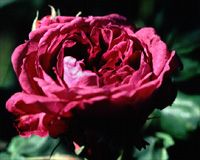
Reine des Violettes. Hybrid Perpetual. (1860) 5-8 feet. Flowers repeatedly.
(wren day vee-oh-LETT) Zones 5-9.
A beautiful rose! I think of pastel crayons from pink through lilac and blue to
deep magenta, smeared one over the other to achieve the delightful smoky effect of
its color. The pink is predominant in the color - in some soils the blue tones are not
so evident and usually can be helped along by feeding the plant chelated iron. It makes
a lovely rounded shrub when pruned minimally, and can climb if supported.
Kansas City resident, Kelley Yeats, said, “As I write I am intoxicated by the scent
of a vase full of Reine des Violettes . . . they have, as always, come through this
summer’s drought simply ‘smelling like a rose.’ They are perfection!”
Rosa Damascena Trigintipetala. (Kazanlik) Damascena. (Prior to 1700) 3-4 feet.
One annual flowering. (. . . dahm-ah-SAY-nah tri-gin-ti-PET-ahla) Zones 4-9.
Urn-shaped, shiny red hips adorn the upright, almost thornless plant in fall - one
of my favorite additions to Thanksgiving arrangements. The spring flowers are cherry
red, have soft “wavy” petals and a heavy perfume. Very clean, disease free plant.
Historically important in the collector’s garden.
Excellent for potpourri and attar of roses preparation as the color and perfume stay
with the petals for a long time.
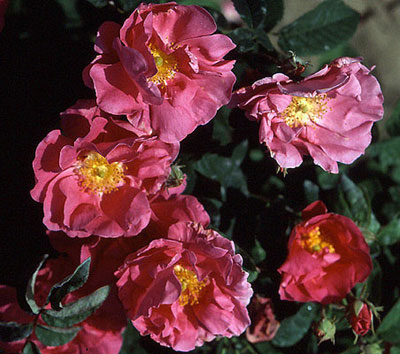
Rosa Gallica Officinalis (Apothecary Rose) (before 1300) 3-4 feet. One annual flowering. Zones 3-9.
(GAHL-ee-kay oh-feess-e-NAHL-iss)
One of the noted varieties used for attar of roses and fine potpourris, and a good garden
rose, too. Light crimson blossoms with intense perfume are semi double and borne freely
in late spring.
This is the “Red Rose of Lancaster”, carried with aplomb as the badge of the Lancasters
during the Wars of the Roses.
Rosa Gallica Officinalis sports very readily, and one can expect one or more variations
on only one plant. We have one in our garden that is half lighter pink, half light crimson as
described above. Rosa Mundi is also one of its sports, and is a striped rose . . . another plant here
is half Rosa Mundi and half Rosa Gallica Officinalis. Do not fault us if your plant develops
sports . . . it is its nature.
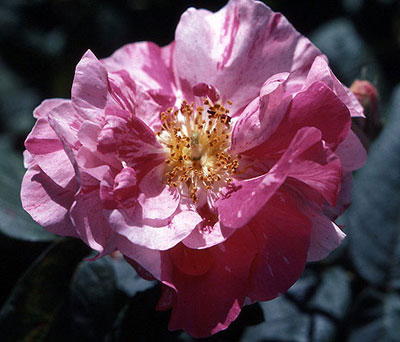
Rosa Mundi. (Rosa gallica versicolor) Gallica. (Prior to 1591) 3 feet. One annual
flowering. Zones 4-9.
The oldest striped rose on record, this is the sport of the Red Rose of Lancaster,
Rosa Gallica Officinalis. Very few books written about roses can be found without
a description of this lovely rose. Low and sprawling, it is at its best in the foreground
of the rose bed, where the red strips over pink ground make a lovely combination
with spring bulbs or perennials, and other old roses. The blossoms are large and open
wide with flaring petals, showing their yellow stamens in the center. Light fragrance.
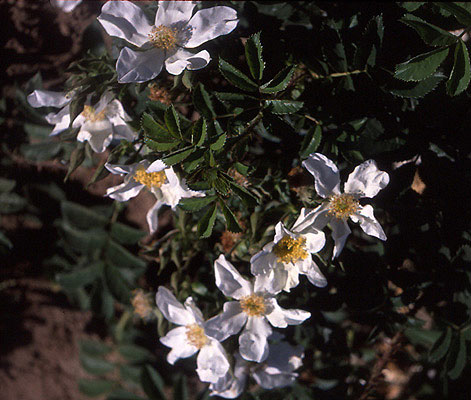
Rosa Paulii. (Rosa Xpaulii) Ground cover. (Prior to 1903) 12 feet. Flowers repeatedly. Zones 4-10.
(PAUL-ee-eye)
For those of you who want a good, thorny barrier and an excellent ground cover.
Excessively clean, light green foliage. The strong shoots first look like they are going
straight up and then lie flat on the ground with successive shoots gradually mounding
up to 3 feet in height. The flowers have a distinct personality among single roses. Each
snow white petal flares widely, standing apart from the next, making the flower four inches
wide, with showy stamens in the center. Blooms in clusters of 6 to 8 blossoms following
one upon the other. Light, spicy fragrance.
Wrote Leland W. Strong, Galesburg, Michigan, “Rosa Paulii wintered with flying colors
- no freeze-back. There is no word I know to describe the profusion of blooms - each entire
cane is in bloom!”
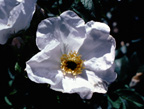
Rosa Rugosa Alba. Rugosa Species. (Very Old) 4-5 feet. Blooms repeatedly. Zones 3-9.
(roo-GO-sah AHL-bah)
Pristine white, single flowers with ivory stamens in the center, and a marvelous
fragrance. . . one cannot ask for more than that, but this lovely rugosa sets edible hips,
very high in vitamin C, and is a fine addition to any rose petal preparation, too.
The plant is compact and thorny with shiny, crinkly rugose foliage, and is extremely
hardy.
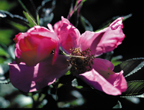
Rosa Rugosa Rubra. (Before 1799) 4-6 feet. Blooms repeatedly. Zones 3-9.
(roo-GO-sah ROO-brah)
An excellent garden plant with good, disease resistant rugose foliage,
more arching in habit than most rugosas. The 3 1/2 inch perfumed flowers
have five petals the color of "vin rose" wine, each standing separately like
the points of a star, and accented at the center by cream colored stamens.
Large orange hips when the petals fall, providing food for the local wildlife.
Likes Northern Coastal conditions.
Rose de Rescht. Autumn Damask. 2-3 feet. Flowers repeatedly (ruz duh rescht)
Miss Nancy Lindsay brought many rose varieties from Persia and France to her garden in England, and this is one of them. Other than this, I do not know its history.
A very compact plant, whose leaves are closely spaced on the canes right up to the flowers, which they encircle; 2 to 2 1/2 inch rosette blooms are bright fuchsia red, with heavy damask fragrance. Evidently closely related to Rose du Roi for the plants are identical in growth and the flowers are similar, except for a slight variation in color.
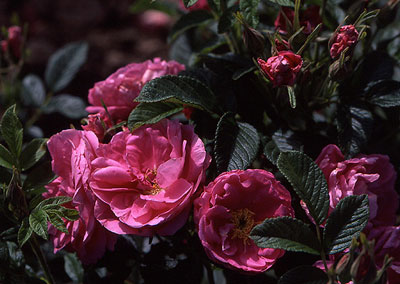
Roseraie de l'Hay. Hybrid Rugosa. (1901) 5-6 feet. Flowers repeatedly. Zones 3-10.
(ruz-ehr-AYE)
I can just hear the sighs of happiness! We finally have this lovely Rugosa hybrid
back again!
Dense, luxuriant rugose foliage covers the entire plant, and the color is a deep
purplish red with rosy overtones. The petals fold over one another and it shows light
yellow stamens in the center of the 4 1/2 inch bloom. Don't stick your nose in the
middle of the blossom without looking for a bee first! There almost always is one
down in a flower fold. If you have a perennial bed, this is a good rose to combine
with blue and pink flowers.
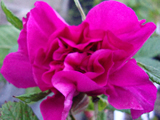
Rugosa Magnifica. Rugosa. 4-5 feet. Flowers repeatedly.
A spreading plant with handsome, glossy, ribbed foliage common to all Rugosa roses, and carmine double blooms that are strongly perfumed. The bees hover around all the Rugosa roses and pollinate the flowers so that beautiful, round, orange red hips form. The plant flowers and sets hips at the same time, so if you want the large hips to form do not remove spent flowers. Very hardy and recommended to everybody anywhere. You couldn't be disappointed with this rose.
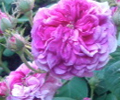
Russelliana. Hybrid Multiflora. Prior to 1926. . 10’ – 20’ (10’ width). Zones 4-9.
One of the most beautiful ramblers, with very fragrant, very double, flat blooms that are a deep violet red in the center with a circling of lighter pink to lavender edges. Clusters of medium sized blooms cascade all around the mass of disease resistant dark green fragrant foliage. Blooms once annually through May and June, and when in bloom, everyone is excited to find a place to let this bold beauty take over a part of their yard. Will get up 10 to 20 feet high and 10 feet wide.
Salet. Moss. (1854) 3-4 feet. Flowers repeatedly. (sah-Lay) Zones 4-9.
Salet blooms as consistently as a Floribunda, and is the best of the Moss roses that bloom repeatedly. Flared, well mossed sepals enclose beautifully formed clear pink buds and open flowers with many small, closely packed petals.
Foster Mellier, writing about roses for distillation of perfume in 1902, stated . . . "The real odour of musk is to be found only in Salet." The glands on calyx and stems also secret a musk odor and a cut bloom will perfume the hand that holds it.
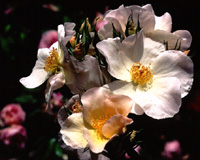
Sally Holmes. Shrub. (1976) 6-7 feet. Apricot/White. Flowers repeatedly. Zones 5-9.
A show stopper in our garden - visitors gasp and cross the garden to
get a closer look at a rose that has bloom trusses of a size that are truly
unbelievable! At least 40, 3 1/2 inch, single ivory/white flowers to each
strong branch. And the bloom is continuous throughout the season on a plant
with dark green, shiny, disease resistant foliage. Has a light fragrance that
attracts bees.
A shrub of large proportions, this is not for the small garden. Wonderful
when placed against a fence, wall, or is allowed to send its tall shoots into a
small tree.
Shot Silk, Climber. Climbing Hybrid Tea. (1931) 10-15 feet. Flowers repeatedly. Zones 5-10.
A high centered, double, richly fragrant rose of unique and beautiful color; cherry cerise, shot with gold to give an all over effect of coral pink. Fine cutting stems and glossy green disease resistant foliage. "Shot Silk is lovely . . . like nothing else in my rose garden or any of our friends or neighbors." Mrs. Juanita Zuck, Columbus, Ohio
Silver Shadows. Hybrid Tea. Griffith Buck. (1982) 2-3 feet. Silver. Fragrant. Flowers repeatedly. Zones 6-10..
Lavender Hybrid Teas are readily available, but you will not find one with this coloration among them. On my desk, as I write his, I have two blooms in a blue bud vase. Absolutely breath taking! An unusual shade of white with greyish overtones, the petals in the beautifully formed double blossoms have a faint lavender edge, more pronounced in cool weather. The fragrance is citrus with musk overtones and is very strong. An amazing crown on an already illustrious career, this is one of Griffith Buck's last, and best, hybrids.
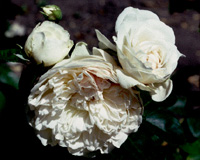
Sombreuil. Large Flowered Climber. (1856) 7-12 feet. White. Light fragrance. Flowers repeatedly. (som-broo-EE) Zones 6-10.
The finest ivory climber in the rose world - flat blossom, full of
petals and fragrance enough to fill a room.
Mary Marsden wrote us some years ago from her home in Garden City, New
York, "It is breathtaking! The beauty of the flowers just thrills me every time I
walk by - I just can't tell you how much pleasure this rose has given me!"
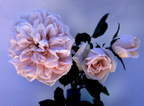
Souvenir de la Malmaison. Bourbon. (1843) 3-5 feet. Pale Pink. Fragrant. Flowers repeatedly. Zones 5-9.
(duh lah mahl-may-ZAWHN)
An historic rose, from France to our gardens. Full, tight perfect buds open slowly
to show many tightly curled petals full of fragrance. Palest pink opening almost
white.
Factually it is very hardy...no freeze-back even in the coldest Pennsylvania; a moderate
grower, but a profuse all-season bloomer. A sunny protected position is best, as well as a
garden with low rainfall, as wet weather can keep a bloom from realizing its glory.

Souvenir de la Malmaison, climbing. Bourbon. (1893) 10 feet. Pale Pink. Fragrant. Flowers repeatedly. Zones 5-9.
(duh lah mahl-may-ZAWHN)
I find it difficult to select the right words, for this is not just another old-fashioned
rose, or can you describe its many subtle qualities with the usual catalog superlatives.
Factually it is very hardy...no freeze-back even in the coldest Pennsylvania; a moderate
grower, but a profuse all-season bloomer. Flower is large, many-petalled - a pearly
soft flesh-pink. Full, tight buds open slowly to show many tightly curled petals full
of fragrance. A sunny protected position is best, as well as a garden with low rainfall,
as wet weather can keep a bloom from realizing its glory. This rose is well suited
trained over an arbor, providing a lovely canopy for a bench.
An old-world rose which speaks of history, romance and nineteenth century
“Paris in Spring.”
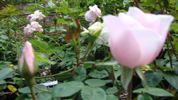
Souvenir de St. Anne. Bourbon. (before 1916) 4-6 feet. Pale Pink. Fragrant. Zones 5-10
From the Graham Stuart Thomas Rose Book, " This originated in Lady Ardilaun's garden -- St. Anne's, near Dublin -- and was carefully preserved by Lady Moore at Willbrook House, Rathfarnham, Dublin, for many years... A nearly single sport of 'Souvenir de la Malmaison'... The scent emanates from the stamens, not the petals, a trait inherited from Rosa moschata, one of its parents." A very nice garden shrub with the fragrance and color of Souvenir de la Malmaison, yet delicate semi-double blooms won't ball. Blooms in flushes throughout the season.
Stainless Steel. Hybrid Tea. (1997) 4-6 feet. Flowers repeatedly. Zones 4-9.
An excellent cutting rose with classic form and easy to grow and care for.
Long-lasting richly perfumed pastel lavender blooms on long stems with deep green
large leaves on a tall vigorous plant. Flower size and color best with some
cooler temperatures. Fashionable for bouquets and a good contender for awards.
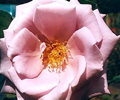
Sterling Silver. Hybrid Tea. (1957) 4 feet. Flowers repeatedly. Zones 6-9.
The famous ancestor for nearly every modern lavender variety, many know
Sterling Silver as it has often been used in bouquets. Shapely pointed buds, that
open to sweetly fragrant flowers reminiscent of citrus blossoms and fruit bloom
repeatedly, novel for its silvery hues. The foliage is glossy green and plants
once established give blooms of better size and color.

The Fairy. Polyantha. (1941) 2-3 1/2 feet. Repeat bloom. Zones 4-9.
In 1956 Will Tillotson wrote..."In ten successive catalogs, the writer has
offered to 'match this beautiful Polyantha against the field and take all bets.'
Except under the desert blistering sun, where its mid-summer blooms fade to
white, The Fairy is unexcelled for vigor, spreading growth, perfect health and
hardiness, and its super ability to produce those charming pink rosette type
blossoms in constant abundance...each fair flower, crisp and waxen like a
pink sea shell.'
Polyanthas come and go, but The Fairy will be with us long after many of
today’s favorites are forgotten. Needs full sun for blooms to open.
conditions. Also available, Pink Grootendorst with soft pink
flowers.
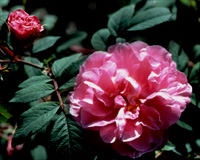
Therese Bugnet. Shrub. (1950) 4-6 feet. Flowers repeatedly.
(tay-RESS boo-NAY) Zones 3-9.
Classed also as a Hybrid Rugosa, this extremely hardy rose was
developed by George Bugnet, of Alberta, Canada, where it gets very cold.
Clusters of from 3 to 5 buds with graceful slim sepals, open to good
sized, fragrant, lilac pink very double flowers. The crinkled petals are distinctly
veined. Makes a handsome plant with healthy foliage in a lovely shade of
blue/green. Very few thorns on the green shaded red canes.
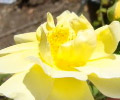
Topaz Jewell. Hybrid Rugosa. (1987) 3-5 feet. Flowers Repeatedly. Zones 4-8.
Alos known as the "Yellow Frau Dagmar Hastrup," this is one of the few, if only,
repeat blooming yellow roses of the rugosa family, which are known for their cold
hardiness, disease resistance, and fragrance. This bush benefits from a harder pruning
than what most rugosas need. The shrub can kept anywhere between 2 to 5 feet high,
and can get 7 feet wide if you let it.
Beautiful medium yellow open faced blossoms have approximately 20 petals and they
have a strong fragrance with a clove scent, similar to Hansa. Not as vigorous as most rugosas
to start. Once established, they can be pruned regularly to half their size. This rose is a
descendent of Belle Poitevine and Golden Angel.
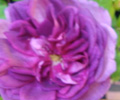
Tour de Malakoff. Centifolia. 1856. 3-5 feet. Strong fragrance. One annual bloom.
As a family, the Centifolias are fast disappearing from commercial growing fields.
Desirable roses, they are not easy to mature to harvest since they have a sprawling
habit of growth. For that reason we seldom have enough plants to satisfy the demand.
The plant is vigorous and arching, and it bears its blooms all along the canes. Pink,
with violet shadings, the blooms have flared petals that are almost translucent, and are
very fragrant. A very fine addition to the perennial bed, and just the right coloring.
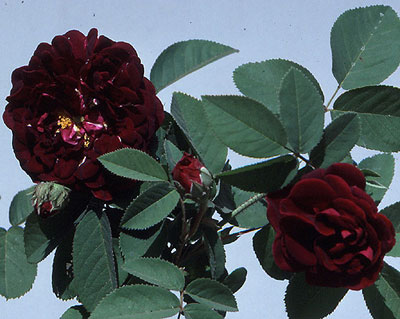
Tuscany Superb. Gallica. (Prior to 1848) 3-4 feet. One annual flowering. Zones 4-9.
A sturdy plant with trim, dark foliage, almost thornless strong stems and flowers so
rich in depth of color the effect is like draped, blackish crimson velvet, catching light
in its folds. Large, flat and full of petals brightened by yellow stamens at the center,
the flowers are exquisite and intensely fragrant. Excellent for colorful potpourri.
John Brayton, of Winston-Salem, North Carolina, says, “Tuscany Superb was
covered with huge, deep-shimmering purple, fragrant blossoms this year - I expect
an even bigger show next year. These are the most unusual blooms I have ever seen -
no photograph that I have seen does them justice.”
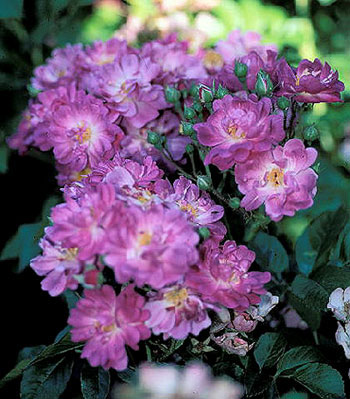
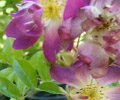
Veilchenblau. Hybrid Multiflora Rambler. (1909) One annual bloom. Zones 4-10.
(FILE-ken-blou)
Large clusters of cupped semi double violet fragrant blooms, streaked with white
coming from the center of yellow stamens, can be trained to climb a pillar or fence and is
well suited for a trellis as it has few thorns. The violet blooms fade to blue-gray with age.
Will tolerate partial shade without forfeiting color and is drought resistant. Prune sparingly,
to clean up dead wood, in the spring.
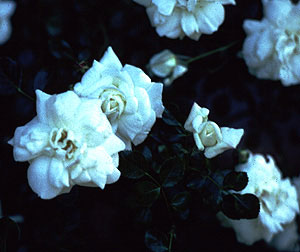
White Dawn, Climbing. Large Flowered Climber. (1949) 10-12 feet. Blooms
repeatedly. Zones 4-9.
Snowy white, camellia-form blossoms that last a long time on the plant
are in great abundance from early spring to late fall. The plants are arching
and trailing in nature, so are good planted in a border situation or on a bank.
Equally good when planted on a medium height fence where it can be trained
up to the top and then be allowed to fall gracefully over the other side. The
foliage is shiny, dark green and disease resistant.
White Wings. Hybrid Tea. (1947) 3-4 feet. Flowers repeatedly. Zones 5-10.
White Wings and Dainty Bess are probably the two best loved five petaled hybrid tea roses, and Dainty Bess is a parent of White Wings. Very long, narrow buds open their five snowy white petals wide to show the exquisite pattern of garnet red stamens at the center. Unusual honeysuckle scent. The plant is vigorous with excellent foliage and long, strong stems. William Ryan III, of Charleston, South Carolina, says White Wings is "good in hot, humid weather and shows no sign of blackspot or mildew."
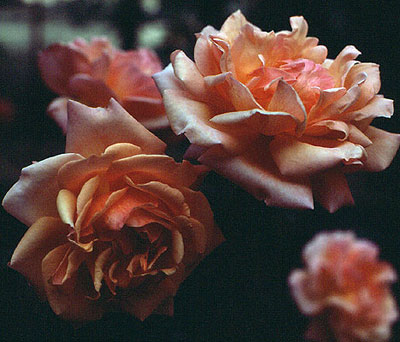
Wild Ginger. Griffith Buck. Grandiflora. (1976) 4 feet. Flowers repeatedly. Zones 4-10.
Soft orange tones, suffused with yellow and tan, are seen at all stages of an opening
bud of Wild Ginger. Deep bronze foliage gives an interesting color contrast to the
usual green of other roses. This is a modern color, much admired by our visitors,
that is really exceptional when planted in a bed of blending colors, such as with Just
Joey, Abraham Darby, Fragrant Cloud and Lady Hillingdon.
Admired by Alexander Mesrobian, Bath, Maine, he wrote of Wild Ginger,
“. . . vigorous and prolific, with buds and blooms showing many shades of orange/pink/
yellow/buff. Its strong fragrance was an interesting blend of nutmeg and banana. Buds
and foliage survived a series of fall frosts, extending our Maine summer.”
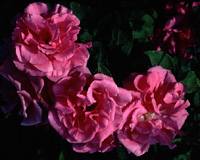
Zephirine Drouhin. Bourbon. (1868) 6-8 feet. Blooms Repeatedly.
(zeff-ur-een DROO-han) Zones 5-10.
Beautiful in every stage, from bud to semidouble open bloom, the flowers are big,
clear bright pink, with a delicate but strong perfume. Can be used as a large shrub
or small climber and is valuable for close quarters because it has no thorns. Disease
free, rich green foliage.
Zepherine does not grow large canes in the growing field and one must realize the
plant you receive may not be as vigorous looking as other types of roses - give it time
and care and it will reward you ten fold!

